Very often, your ability to succeed in digital marketing often comes down to your ability to execute on tried and tested tactics, as well as novel trends.
At the moment, you might feel as though you’re doing a good job when it comes to tried and tested tactics, but you may feel as though you’ve hit a plateau. If that’s the case, you might be interested in learning about the latest digital marketing trends so that you can update your digital marketing strategy.
Well, in this post, we’re going to look at some of the top digital marketing trends you should focus on. If you want to develop a cutting edge marketing strategy, these trends will help you get off to a good start.
Let’s begin!
Get brand new marketing strategies straight to your inbox. 23,739 people already are!
1. Chatbots
To kick this post off, the first digital marketing trend we’re going to look at is ‘chatbots.’ It’s fair to say that chatbots have been around for a while, but they’re now becoming more mainstream. In fact, within the past month, you’ve probably encountered at least one website that has a chatbot.
The chatbot market is expected to grow from $2.6 billion in 2019 to $9.4 billion in 2024. This growth in the chatbot market is related to people’s increased willingness to use chatbots for a variety of needs. If you look at the chart below, you can see that 37% of people would be willing to use a chatbot to get a quick answer in an emergency.
[caption id="" align="aligncenter" width="590"]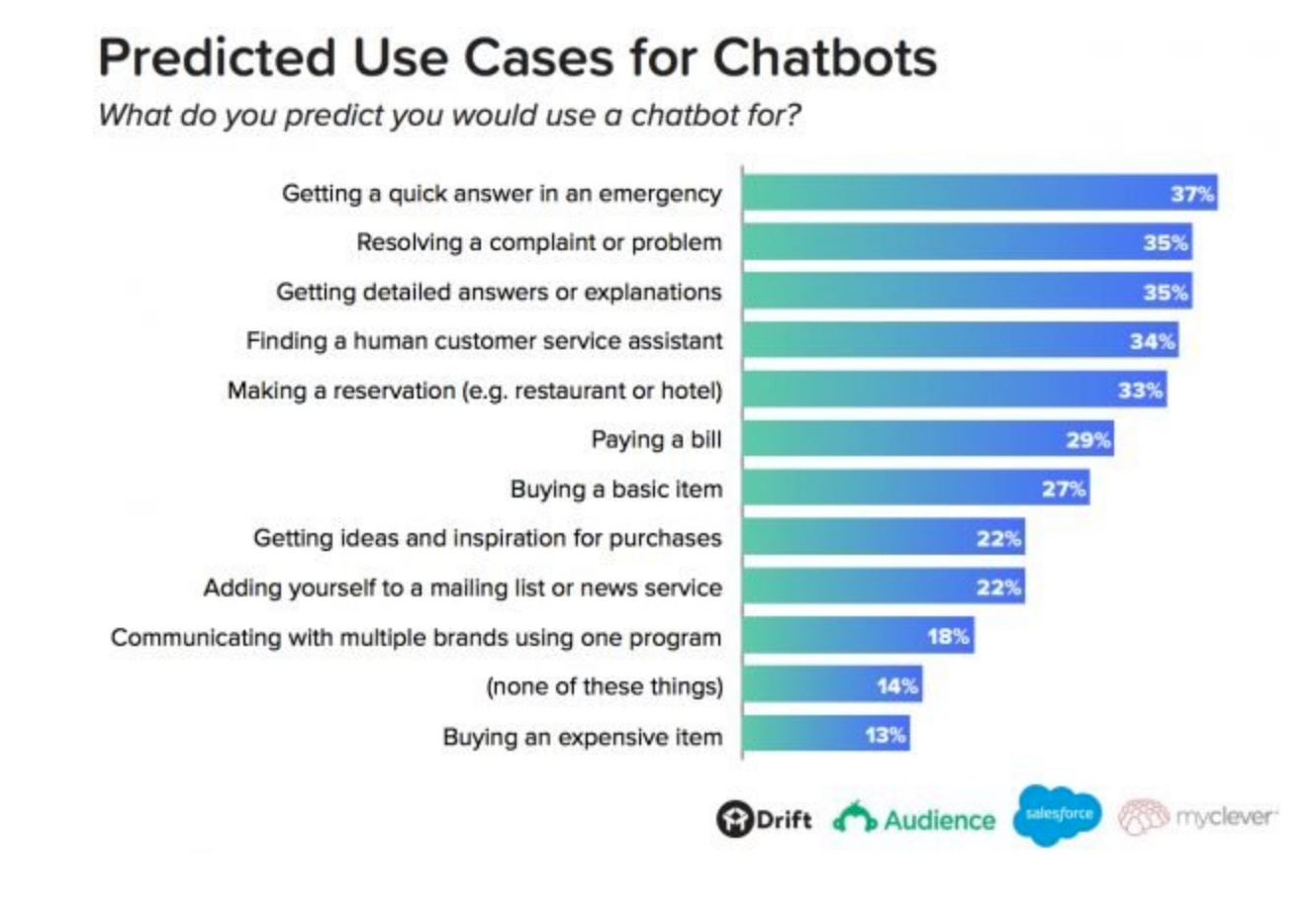 Predicted use cases for chatbots
Predicted use cases for chatbotsSource[/caption]
As you can see from the chart above, chatbots are often used in a customer service context, and they can help existing, and potential customers deal with issues quickly.
This is especially helpful when you consider that 33% of Americans would switch companies due to poor customer service. Additionally, because chatbots can automate certain customer service tasks, they can free up your team so that they can focus on other things.
One of the brilliant things about chatbots is that they allow you to generate a greater number of customers from your website. For instance, if someone visits your website, they might be interested in learning more about a particular offering. Traditionally, this person might have to scroll through ‘product’ or FAQ pages, or they might also need to contact a customer support representative, and they’d then have to wait for a reply to their email.
Well, if your website has a chatbot, people can just interact with the chatbot to instantly get the answers they need. If someone is in the consideration or decision stage of the buyer’s journey, this interaction could be the difference between them buying from you instead of a competitor. Chatbots can also be a brilliant way to generate leads for your business.
[caption id="" align="aligncenter" width="590"]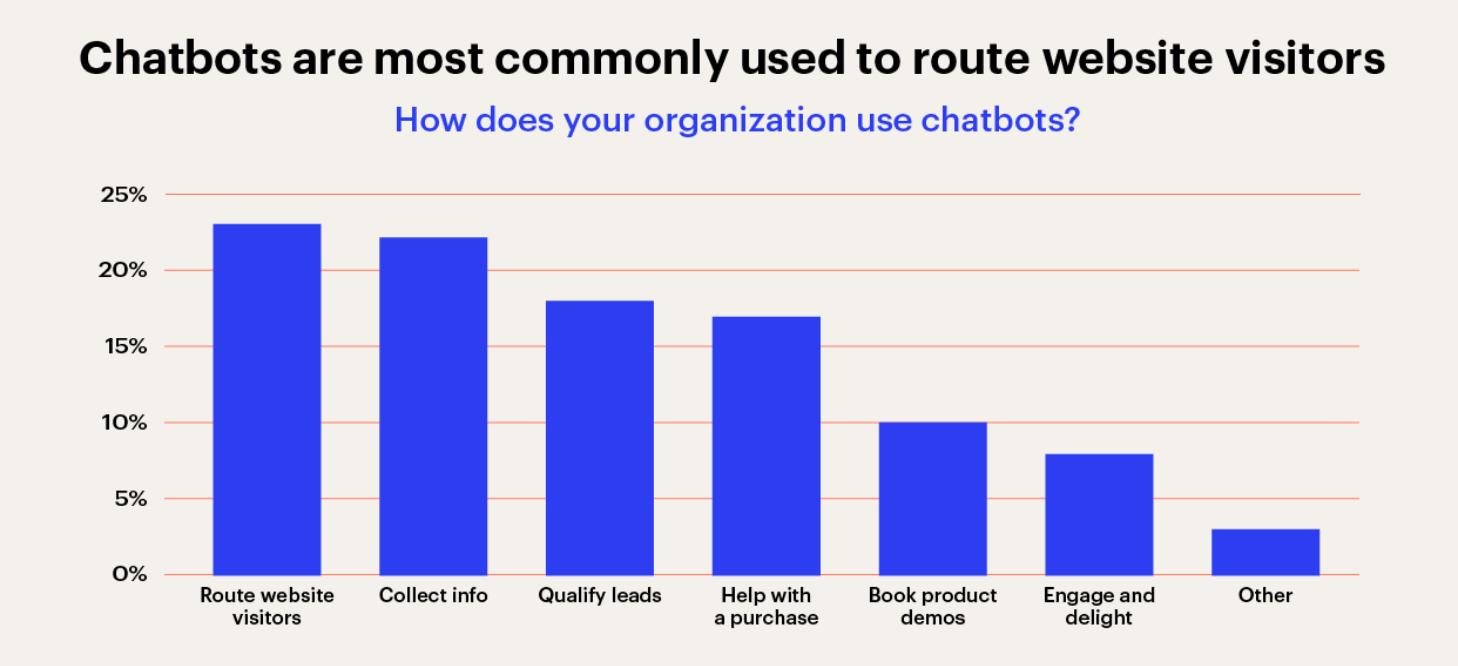 Common uses for chatbots
Common uses for chatbotsSource[/caption]
This is highlighted by the chart above, which shows that around 22% of companies use chatbots to collect info, and roughly 18% use them to qualify leads.
This is all possible because during a chatbot conversation you can ask for certain kinds of customer information.
This then means that you can follow-up with someone after they’ve interacted with your chatbot. Because you have lots of relevant information on a customer, you may also be able to achieve greater conversion rates in regards to closing these leads.
Another good thing about chatbots is that you can set them up so that a ‘real’ customer service representative eventually joins the chat.
This can lead to more sales as the customer service representative might be able to ‘close’ this person via the chat after the chatbot has done most of the heavy lifting.
[caption id="" align="aligncenter" width="590"]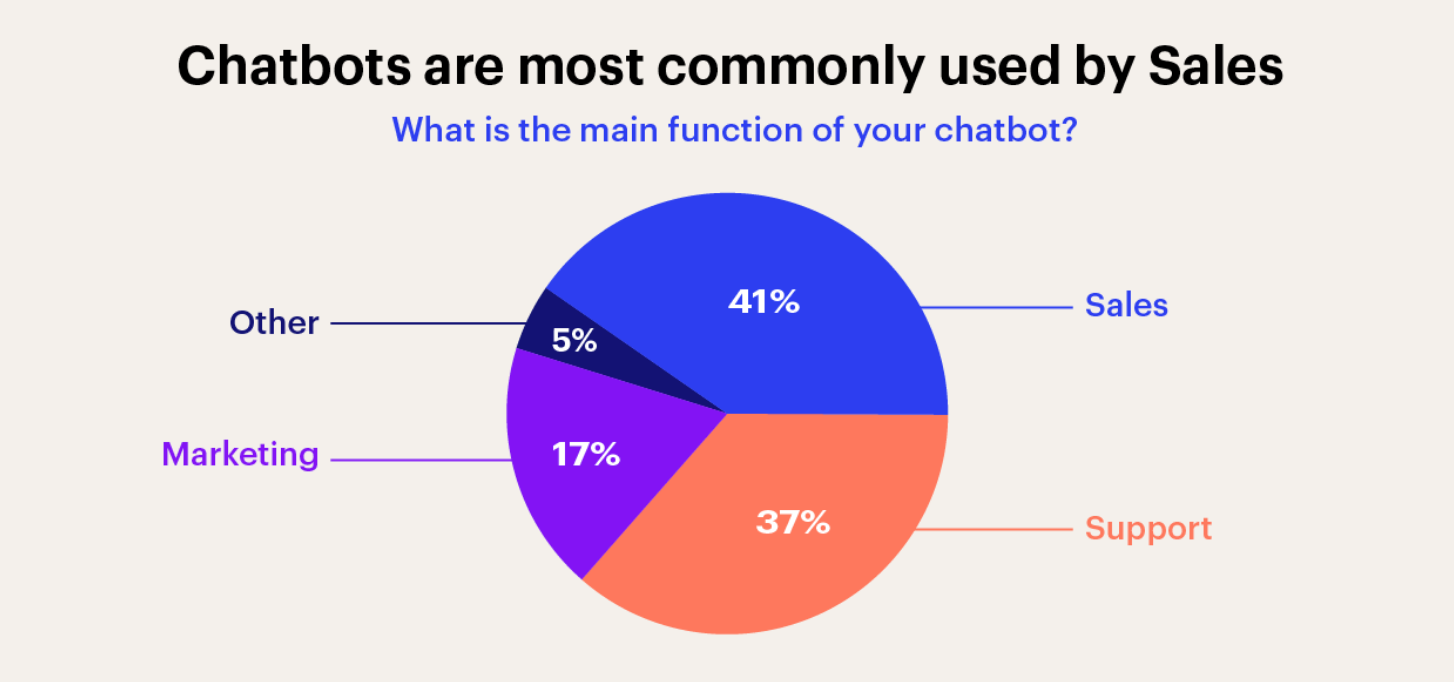 Chatbots are commonly used for sales
Chatbots are commonly used for salesSource[/caption]
It’s because of this that 41% of companies say that their chatbot is most commonly used for sales.
So, with all that said, how exactly do you go about setting up a chatbot on your website?
Fortunately, setting up a chatbot isn’t hard, and there are many services out there, such as ManyChat and Chatfuel, that’ll help you create a chatbot.
If you want to install these tools on your website, you often just need to add a little bit of code to your website. If you use a platform like WordPress, this is relatively easy, and you might even be able to get a plugin that helps you get the job done.
Setting up the automated responses is going to be a bit of a trial and error process, and it will take some time for you to dial this in.
If you want to get off to a good start, you should consider some of the common inquiries people have whenever they email you and ask for help. You could then set up your chatbot so that it helps people with these queries.
Over time, more and more people will interact with your chatbot, and you can use these interactions to improve the way your chatbot deals with customer service queries.
Additionally, some chatbots will make use of artificial intelligence tools such as machine learning.
This then means that they’ll learn from past customer experiences, and they’ll then use this knowledge to provide a better response to future chatbot users.
Furthermore, some chatbots will integrate with social media messaging apps such as Facebook Messenger. Due to this the chatbot benefits mentioned above can apply to your social media marketing channels, as well as your website.
Note that when you’re setting up your chatbot, make sure you always give people the option of speaking to a ‘real’ person. If you just try to automate everything, you might not be able to do a good job when it comes to dealing with customer queries, and thus you might end up with a frustrated customer. If that happens, your chatbot will often end up doing more harm than good.
2. Video Marketing
The next digital marketing trend we’re going to look at is video marketing.
Now, you might think that video marketing has been around for a while and you may not really consider it to be a trend, however, while this is a fair argument, it’s worth mentioning that video content on the internet has yet to peak.
In fact, according to one study, internet traffic will account for 82% of traffic in 2022, which is a steady increase from previous years.
[caption id="" align="aligncenter" width="590"]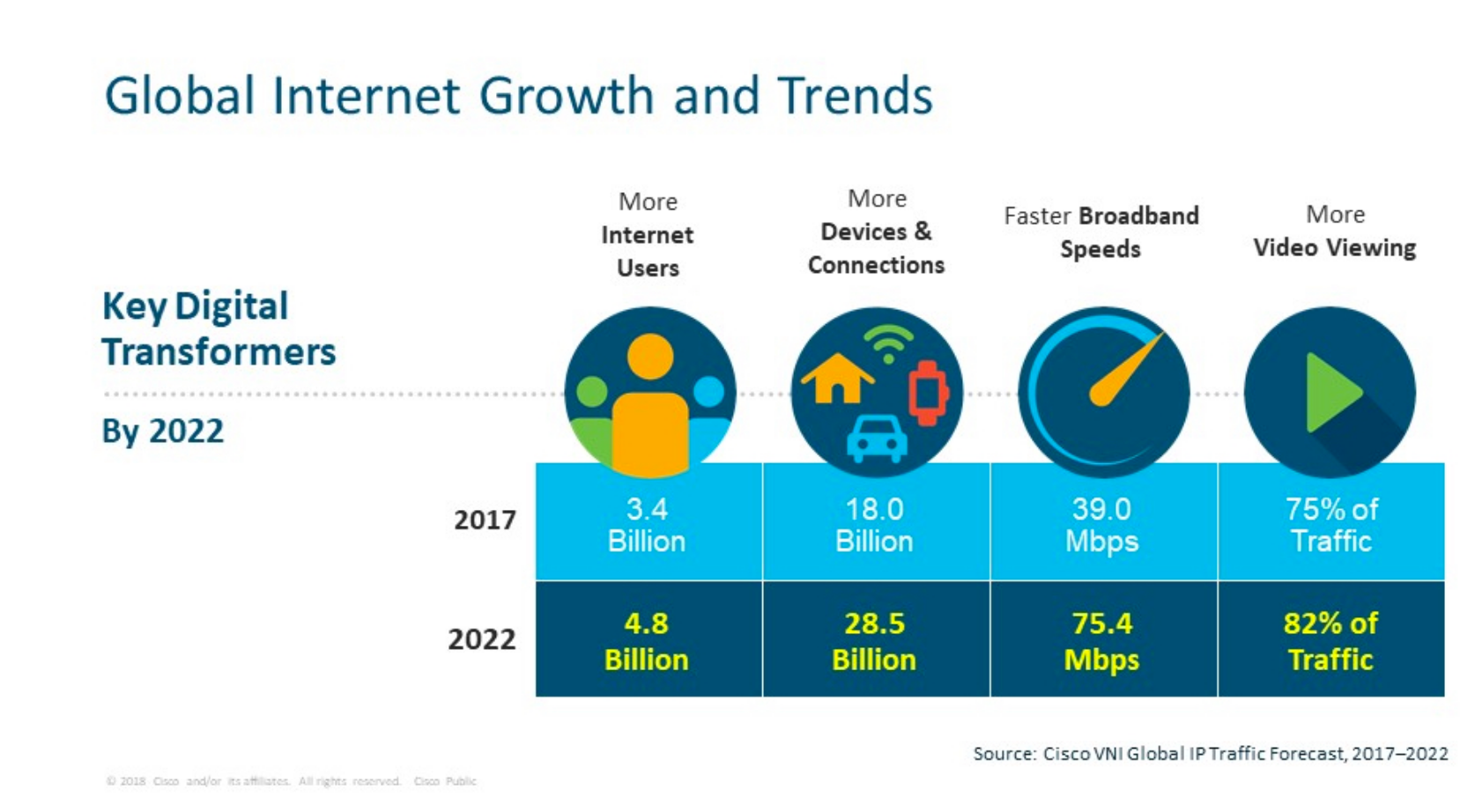 Video growth is expected to grow
Video growth is expected to growSource[/caption]
Furthermore, video consumption could rise even more than what is suggested above due to the advent of 5G. This is because 5G will make it easier for people to consume high-quality video content wherever they are.
If you look at the chart below, you can see how there’s an expected increase in video consumption, after the adoption of 5G.
[caption id="" align="aligncenter" width="590"]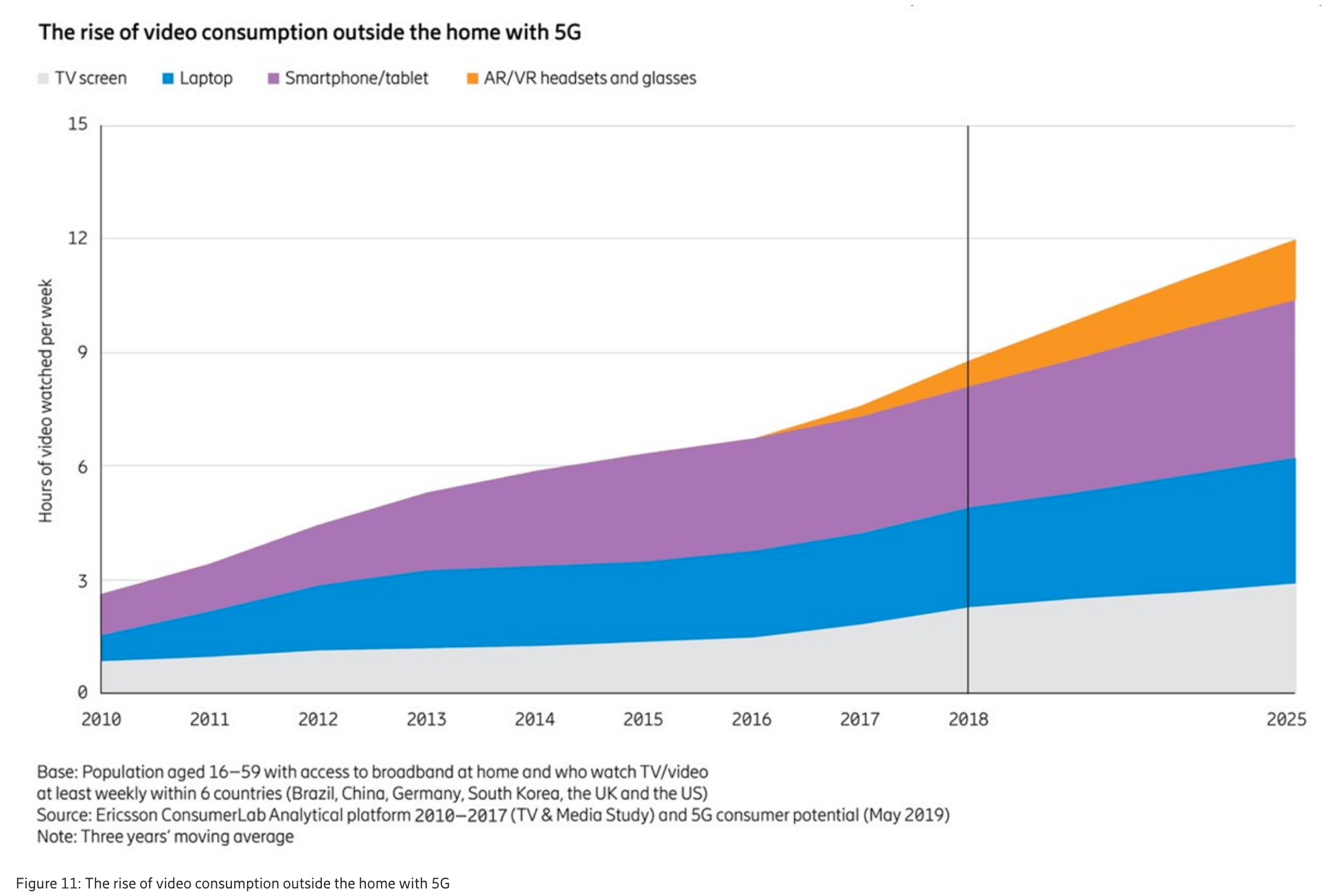 5G will impact video consumption habits
5G will impact video consumption habitsSource[/caption]
Furthermore, when surveyed, 57% of people are most excited about using 5G to watch UHD video content on their mobile devices.
[caption id="" align="aligncenter" width="590"]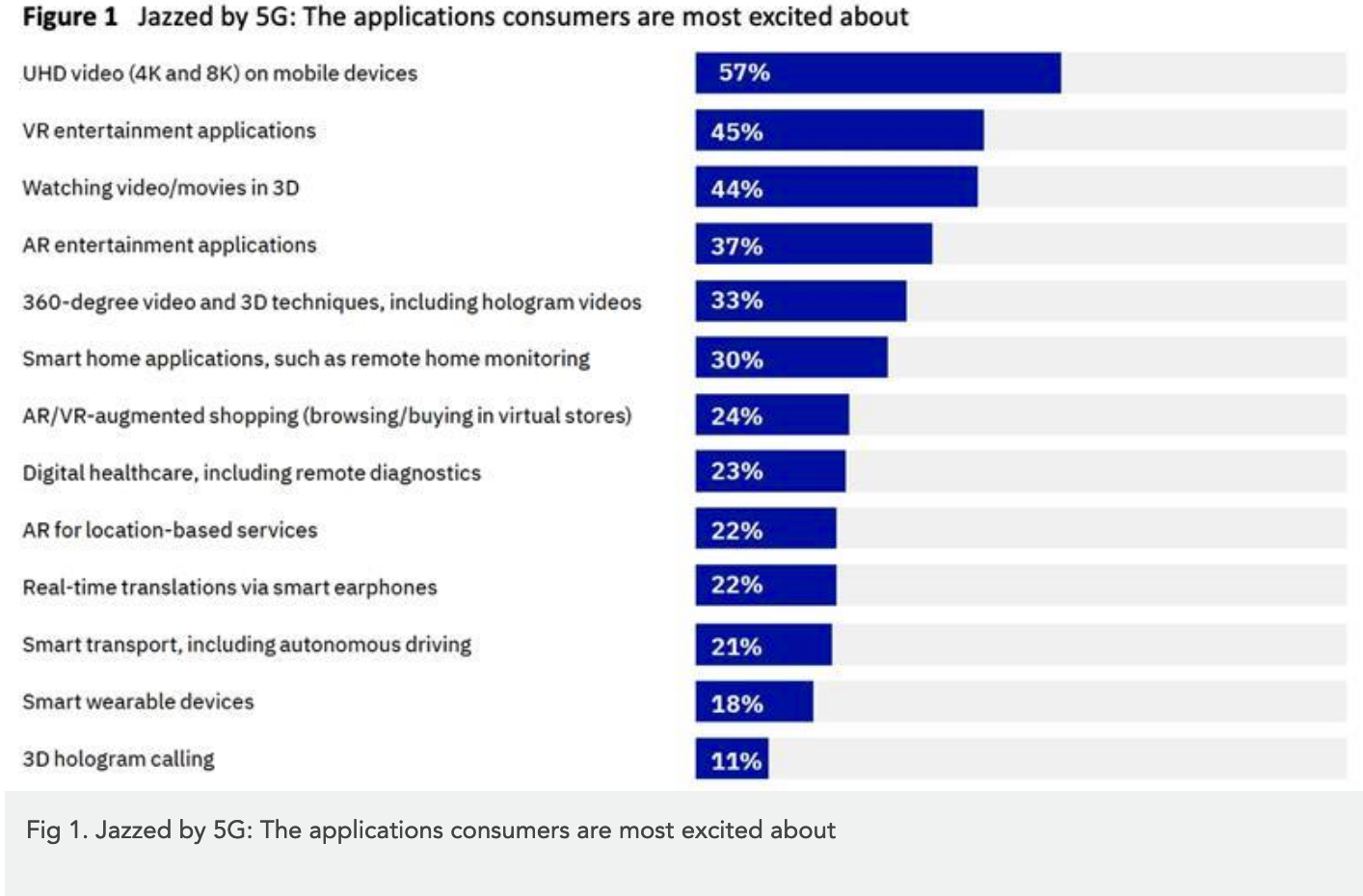 More people will watch UHD videos due to 5G
More people will watch UHD videos due to 5GSource[/caption]
When you combine this with the fact that 86% of people want to see more video content from businesses, it’s clear that video marketing still remains a great opportunity.
[caption id="" align="aligncenter" width="590"]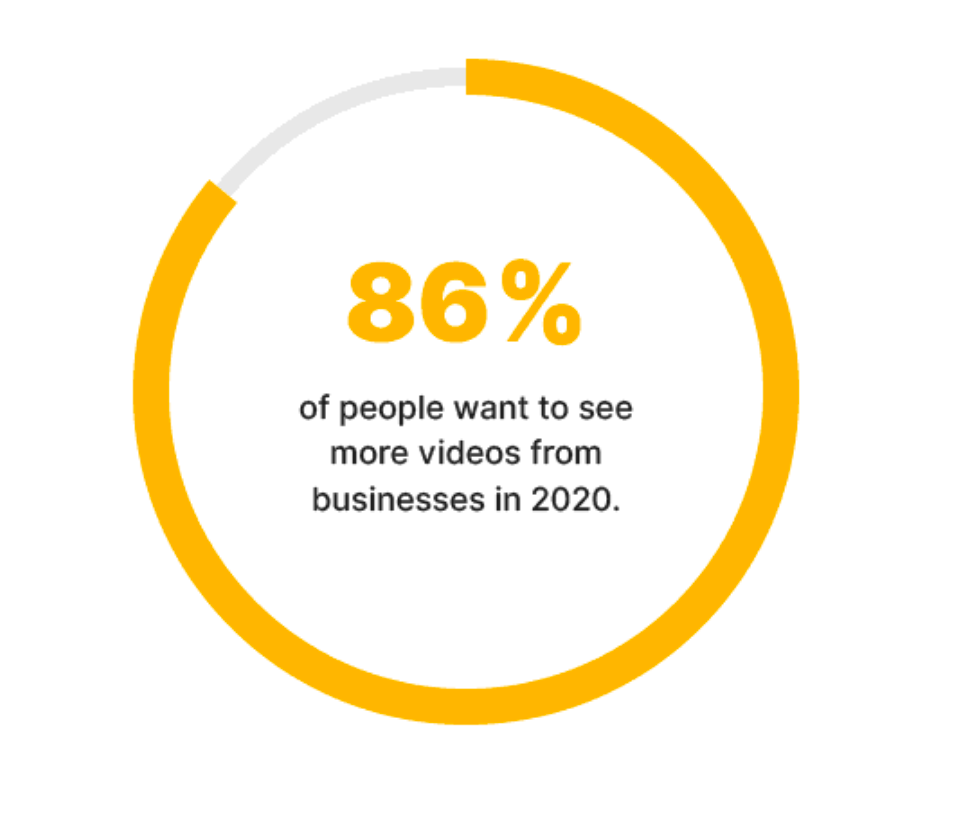 More people want video content from businesses
More people want video content from businessesSource[/caption]
Now, video marketing is a very broad term, and it can mean a lot of things. For instance, if you’re looking to embrace video marketing, you might do the following:
- Post YouTube videos
- Embrace Instagram stories
- Experiment with TikTok videos
- Post Snapchat videos
- Host ‘live videos’ on Instagram, Facebook, or YouTube
- Run social media video ads
If you want to take advantage of video marketing, creating YouTube content is perhaps the easiest way to go about things. This is emphasized by the fact that 78.8% of marketers consider it to be the best platform for video marketing.
If you don’t have much experience with creating video content for your business, you may not know what kind of videos you should actually produce. If you find yourself in that position, there are a number of routes that you can go down.
The first option is to do a ‘behind the scenes’ video, which showcases how people within your company work. Here’s a good example of a manufacturing company that’s based in Kentucky.
[caption id="" align="aligncenter" width="590"]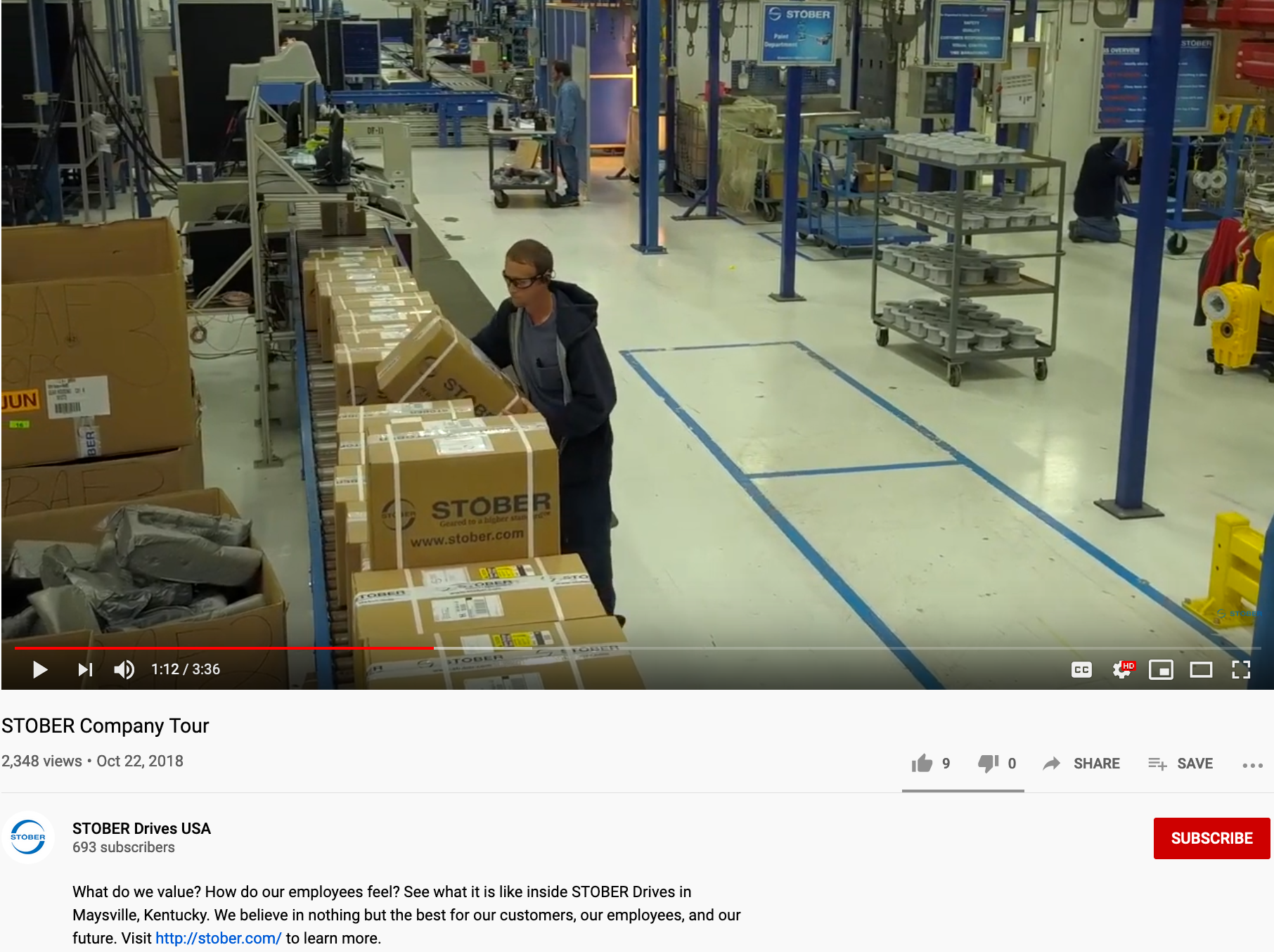 This manufacturing company offers a good ‘behind the scenes’ video
This manufacturing company offers a good ‘behind the scenes’ videoSource[/caption]
Within this video, you might show how you launch a particular product or even how a certain kind of product is actually made. These kinds of videos work well because they give your company a human face, and this can make it so that people feel connected to your company. This is key when you consider that 57% of people will buy more from a brand that they feel connected to.
You might even want to create videos that showcase some of your customers and the results you have delivered. Below you can see a good example of such a video, which is from the Volvo company.
[caption id="" align="aligncenter" width="590"]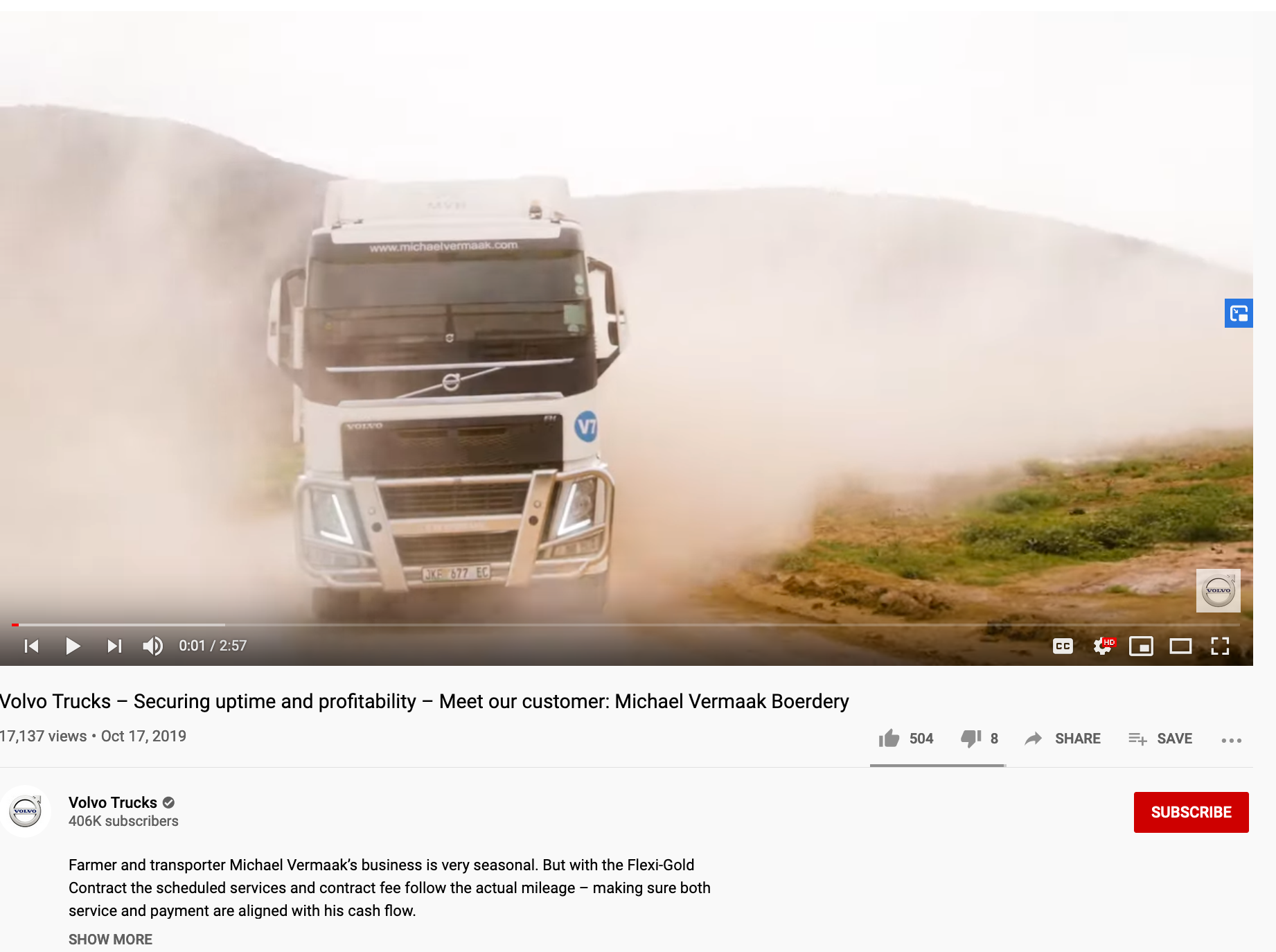 Volvo offers a good customer experience video
Volvo offers a good customer experience videoSource[/caption]
There’s also no harm in creating some lighthearted, entertaining content. The video below, from Mercedes-Benz, is essentially a series based on the life of a crash test dummy, and it’s a good example of such content.
[caption id="" align="aligncenter" width="590"] An entertaining crash test video from Mercedes
An entertaining crash test video from MercedesSource[/caption]
Additionally, you might want to consider creating content that helps people deal with certain challenges associated with your industry. Creating this kind of content is especially worthwhile because 36% of people want to see more educational/explainer forms of content from businesses. Also, because ‘how to’ is the most consumed form of content on YouTube, you should consider posting these sorts of videos to YouTube.
For instance, suppose you have a software product that helps people manage board members. If you’re looking to create content for your YouTube channel, you might create videos that teach people how they can attract good board members. Here’s a good example of explainer content from the makeup brand Chanel.
[caption id="" align="aligncenter" width="590"]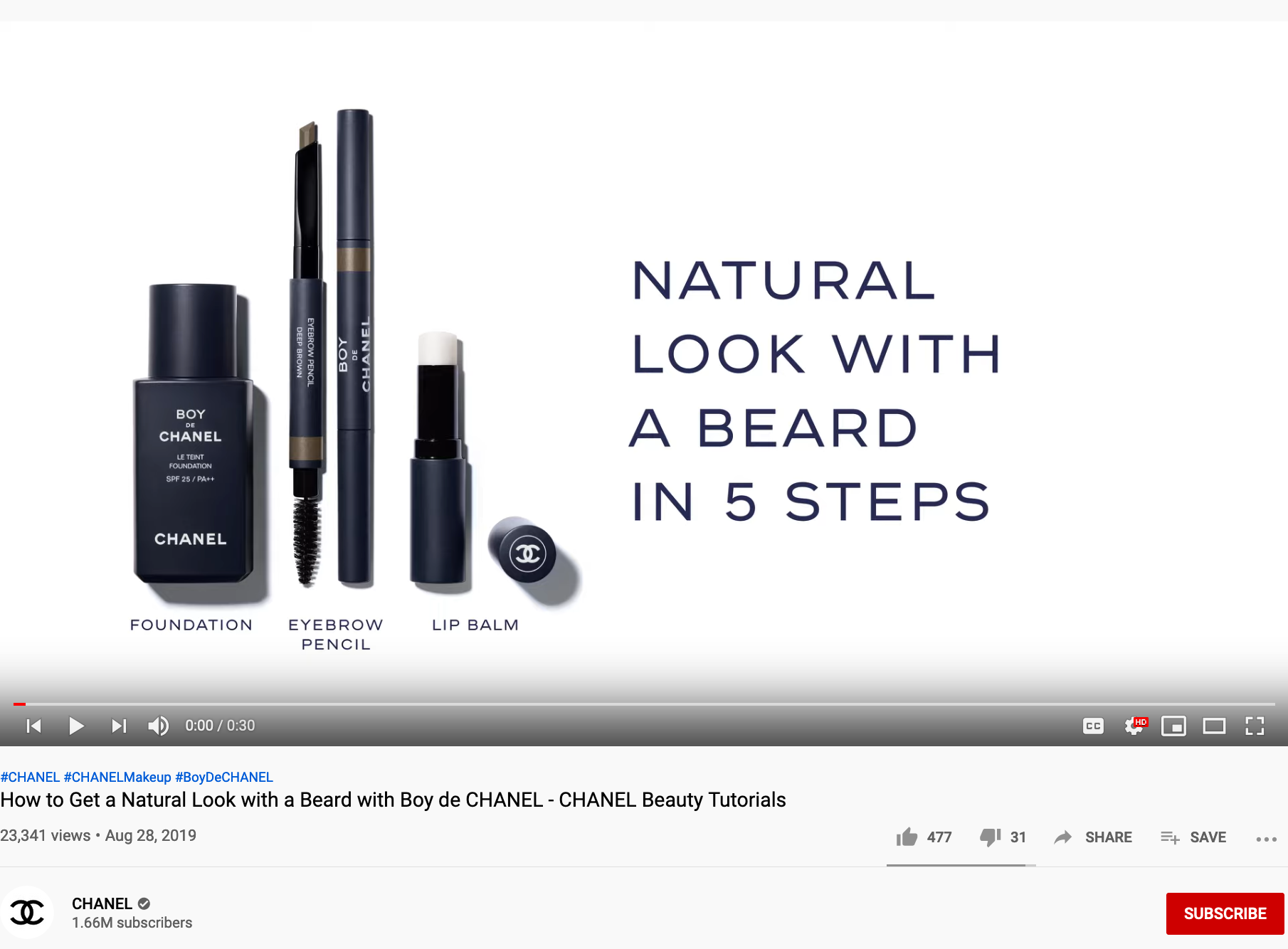 A good example of how-to content from the makeup brand Chanel
A good example of how-to content from the makeup brand ChanelSource[/caption]
If you make an effort to create a lot of content like this, you will naturally develop a lot of brand awareness over time. We’ve focused a lot on YouTube here, but as mentioned, there are lots of other platforms that you can experiment with. You can post videos on social media platforms like Instagram or TikTok.
For the most part, you can stick to the video creation strategy principles we’ve mentioned in relation to YouTube. However, you might have to adapt your marketing strategy so that it’s suitable for the platform you’re using. You’ll also need to adapt your video creation strategy so that it caters to the varying formats supported by a given platform.
For instance, if you’re using Instagram, and you want to just post quick snippets of content, you might use the ‘standard’ 60-second video format. However, if you want to post a long-form piece of content, you’d probably want to use the IGTV format, as this format allows you to record and upload videos that can be up to one hour long.
Most platforms will provide you with varying options in regards to the kinds of videos you can upload, and so you should always clarify what’s possible before you stick with a certain format.
Each platform has its own quirks in regards to what works well, and if you want to figure out what these quirks are, you’ll need to consume some content on these platforms. Sign up for a few accounts in your niche so that you can develop a feel for what does and doesn’t work. You might also want to consider running some video ads on a number of different social media platforms.
More companies are starting to invest in social media video ads, and in the chart below, you can see that social network video ad spending has yet to plateau.
[caption id="" align="aligncenter" width="590"]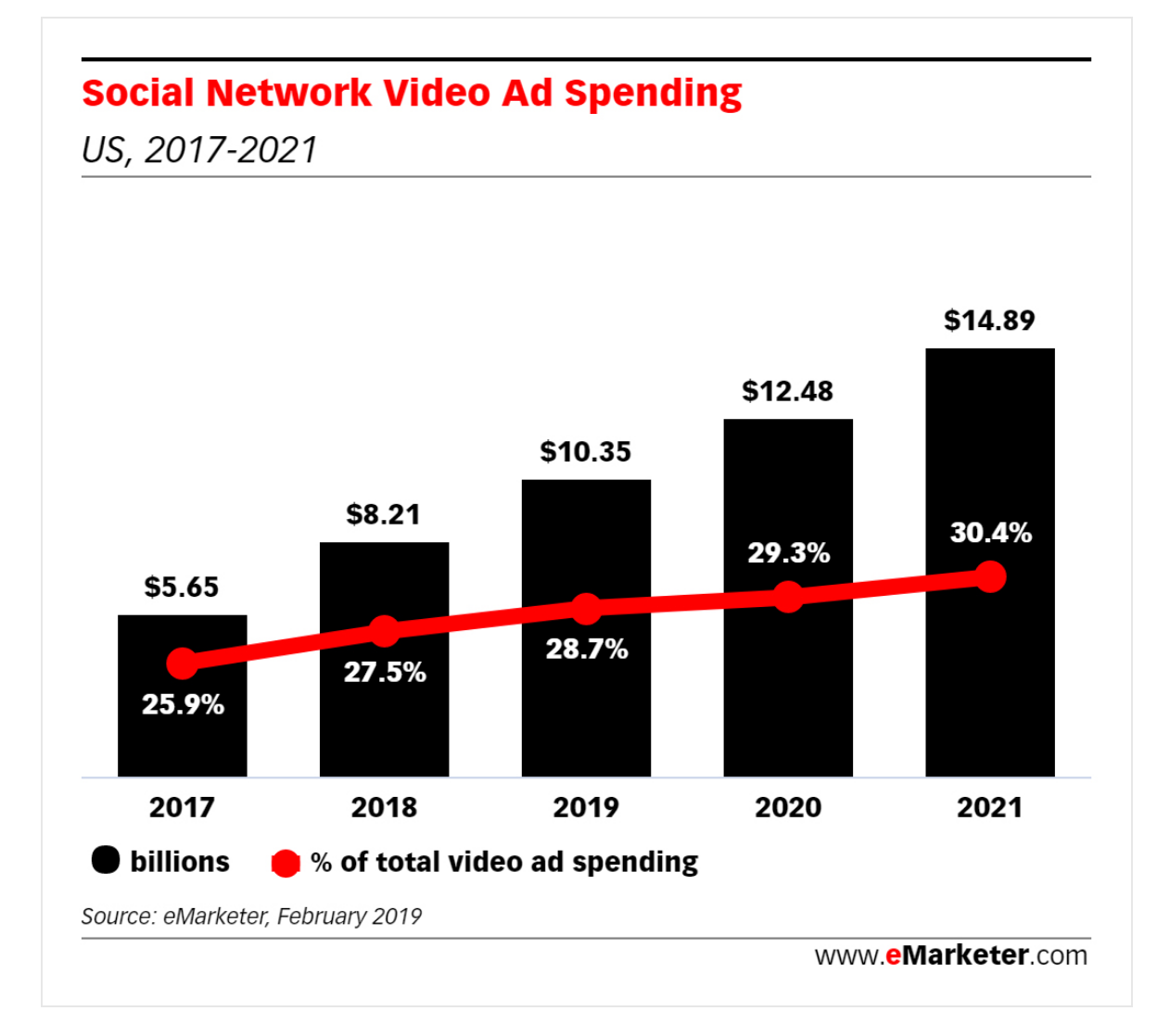 Social network ad spending is set to increase
Social network ad spending is set to increaseSource[/caption]
Running social media video ads is a post in and of itself, and so we won’t go into too much detail here.
3. Omnichannel Marketing
The next digital marketing trend we’re going to look at is something known as ‘omnichannel marketing.’ Omnichannel marketing is worth your time because, on average, companies that focus on omnichannel marketing typically experience a 91% year-on-year increase in customer retention. Now omnichannel marketing can sound like a complicated term, but it essentially means that you provide a coherent, personalized marketing experience across multiple marketing channels.
Providing a personalized customer experience is important because 69% of customers want a personalized experience. Furthermore, companies that make use of three or more marketing channels generally experience higher customer retention rates.
[caption id="" align="aligncenter" width="590"]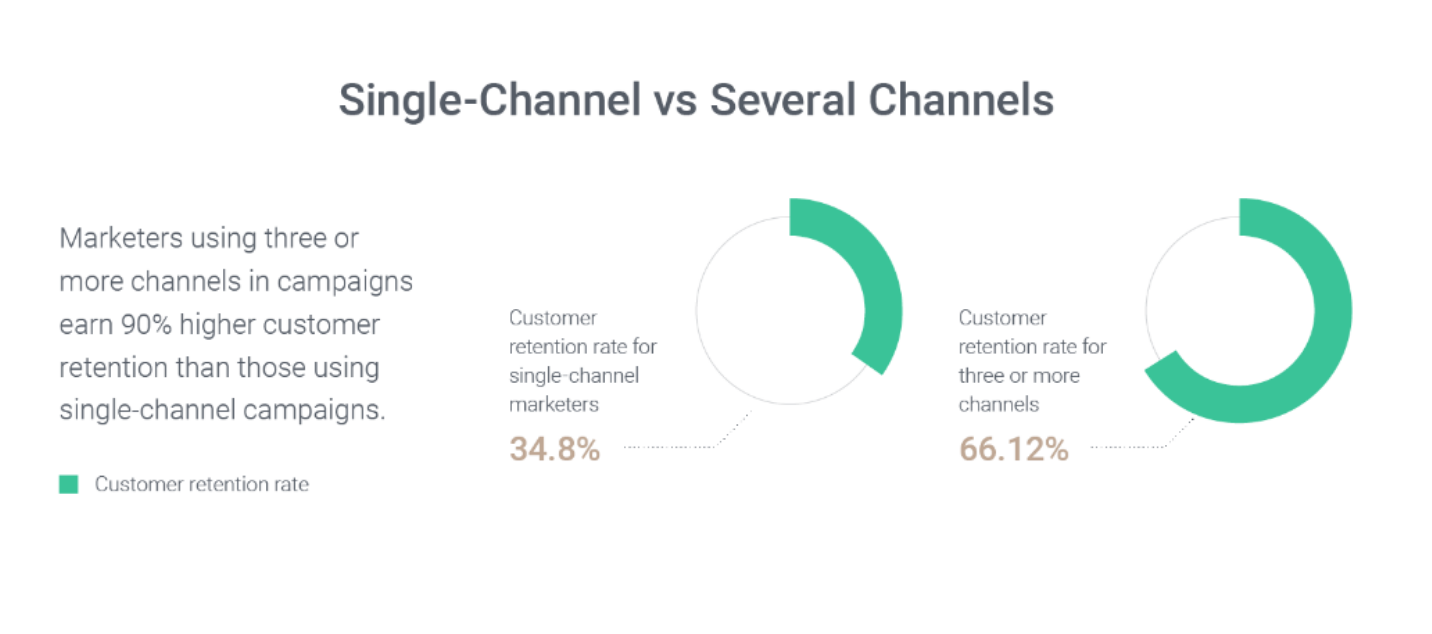 Marketers that use more than one channel achieve better customer retention levels
Marketers that use more than one channel achieve better customer retention levelsSource[/caption]
When you consider these stats, and that omnichannel marketing lets you provide a personalized customer user experience across multiple marketing channels, it’s easy to see why it’s worth investing in. Now, when we talk about marketing channels, we’re essentially referring to all the ways someone might interact with your brand.
So, that could include:
- A mobile website
- A desktop website
- A tablet website
- An app
- YouTube
- SMS
- WhatsApp messages
- Email marketing
- Messages in social media messaging apps
Of course, this list isn’t exhaustive, and there are many other platforms that you might want to consider. It’s worth noting that omnichannel marketing is different from multichannel marketing.
[caption id="" align="aligncenter" width="590"]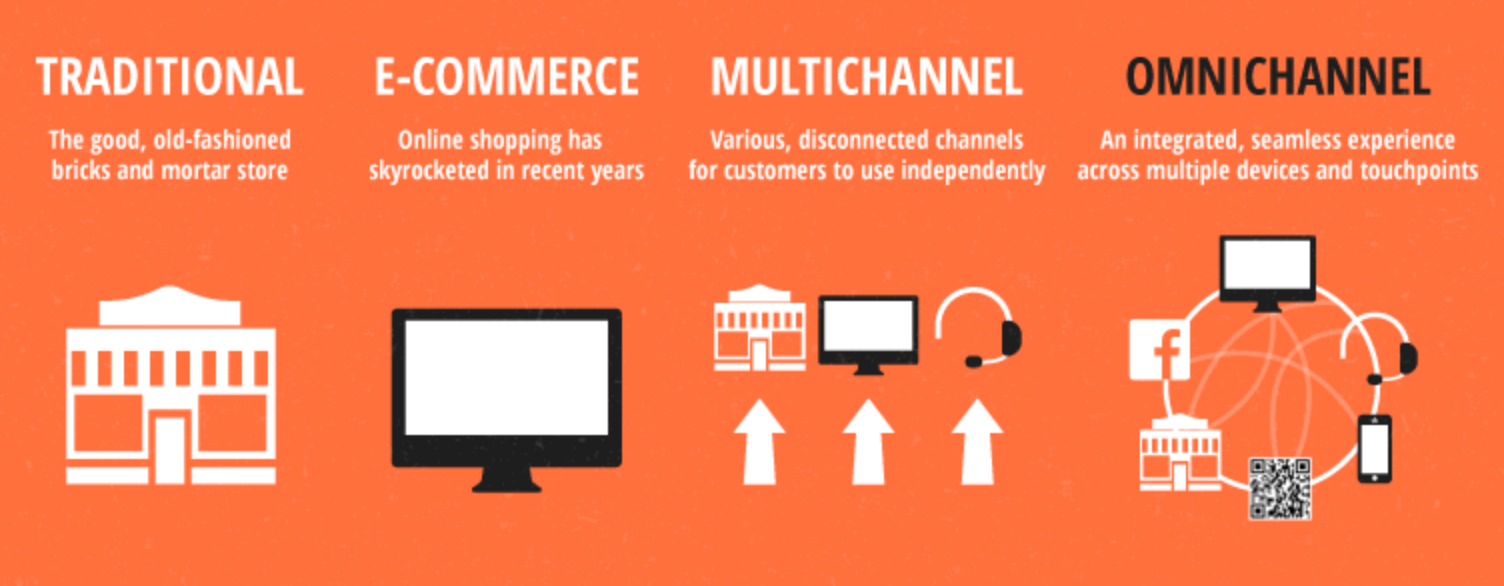 Omnichannel and multichannel marketing aren’t the same things
Omnichannel and multichannel marketing aren’t the same thingsSource[/caption]
Multichannel marketing is essentially when you push out isolated marketing messages to a variety of channels. These different channels work in isolation, and the experience a customer has with one marketing channel will not impact their experience with another marketing channel.
Multichannel marketing is very good if you just want to expand the reach of your brand. With this approach, you can push out lots of content to all the platforms, and easily reach a multitude of people. So, if you have a video, you can repurpose it for each channel, and gain a lot of impressions.
However, this approach doesn’t provide a consistent, personalized experience for people, and so that is where omnichannel marketing comes into play. Omnichannel marketing is different in that it’s focused on the experience of a given individual and where they might be within the customer journey. The marketing messages a customer receives on various marketing channels will be based upon their past actions.
So, the ads they see on Facebook, the emails, or the SMS messages they receive, will all depend on how they’ve interacted with your brand in the past. A basic example of this is someone receiving a cart abandonment message in their email inbox after they’ve visited an eCommerce store. It could also include a retargeting ad after someone has interacted with a certain piece of content either on your site, a social media platform, or within an app.
It’s worth noting that omnichannel marketing often requires the use of certain marketing automation tools, otherwise known as ‘martech.’ Marketing Technology, known as MarTech, are software and technology tools marketers use for marketing campaigns. MarTech is used to automate marketing processes, collect and analyze data in order to reach and engage with your target audience.
If you don’t use these tools, you might not be able to connect different marketing channels together, and thus your ability to create personalized marketing campaigns will be limited. These marketing tools can be expensive, and they can also be hard to learn, and in some ways, this can make omnichannel marketing difficult to implement. This is part of the reason that only 53% of companies only have a few channels connected, and 21% of companies don’t have any channels connected.
[caption id="" align="aligncenter" width="590"]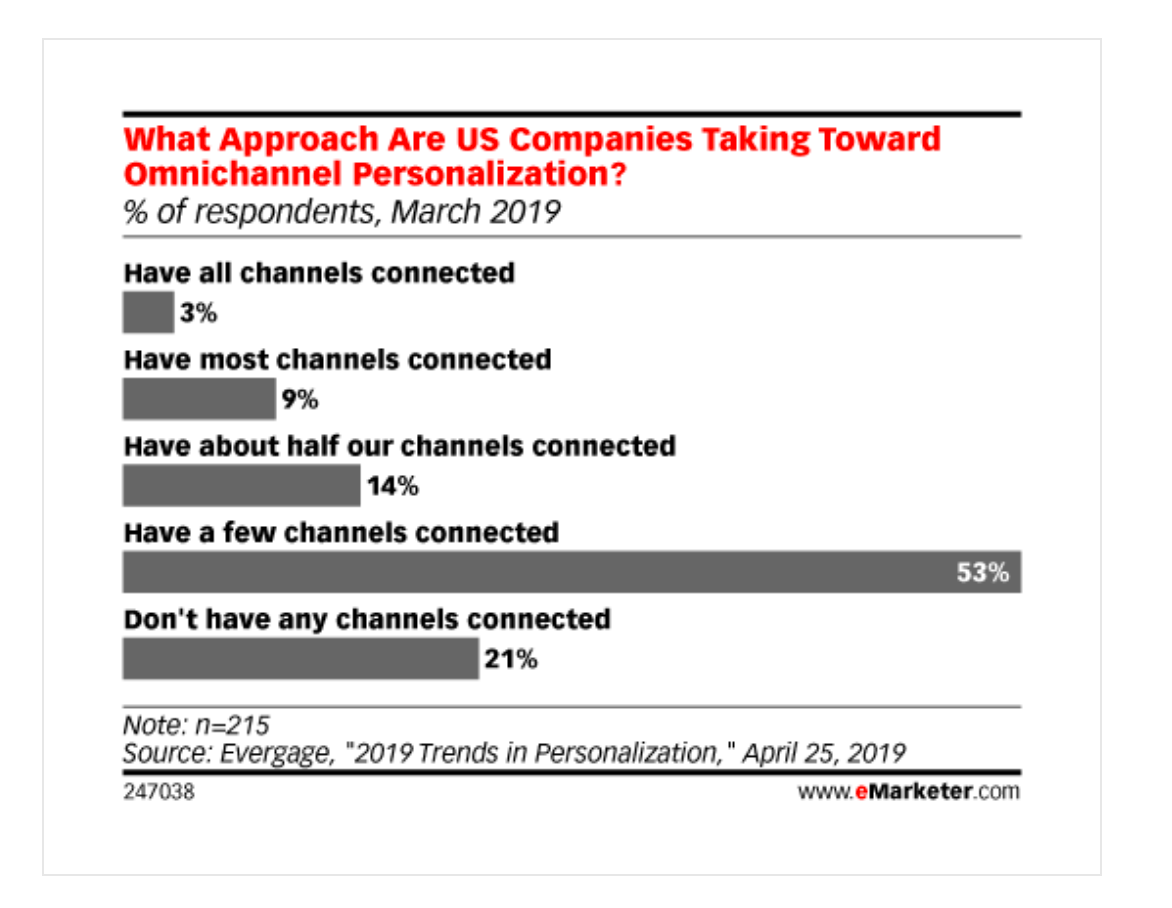 Plenty of companies don’t make use of omnichannel marketing
Plenty of companies don’t make use of omnichannel marketingSource[/caption]
If you want to benefit from omnichannel marketing, you have no other option but to invest in these tools. When you consider the upside of omnichannel marketing, it’s worth investing in this new technology so that you can provide your target market with a great experience.
At the very least, you might want to consider consulting with a company that understands how you can integrate marketing automation tools into your company. With their help, you’ll be able to implement these tools properly, thereby allowing you to create a strong omnichannel marketing strategy.
4. Focus on Digital Customer Experience
Focusing on the digital experience of customers is another digital marketing trend that is gathering pace. That’s because as time goes on, more and more of your potential and existing customers will interact with your brand via a digital medium. If you don’t provide these people with a good digital experience, they will leave and go to a competitor.
In fact, 57 % of customers say that they’ve stopped buying from a company because a competitor was able to provide a better experience. Many brands are taking this seriously, and nearly 48% of companies have created a digital experience team that focuses purely on the experience of customers across digital mediums. Following this, you need to make sure you’re providing customers with a great digital customer experience, or else you’ll lose out to companies that do.
Now, providing a great digital customer experience is a very broad term, and it can mean a wide range of things. However, if you look at the graphic below, you’ll notice some of the key areas that are associated with the ‘digital customer experience.’
[caption id="" align="aligncenter" width="590"]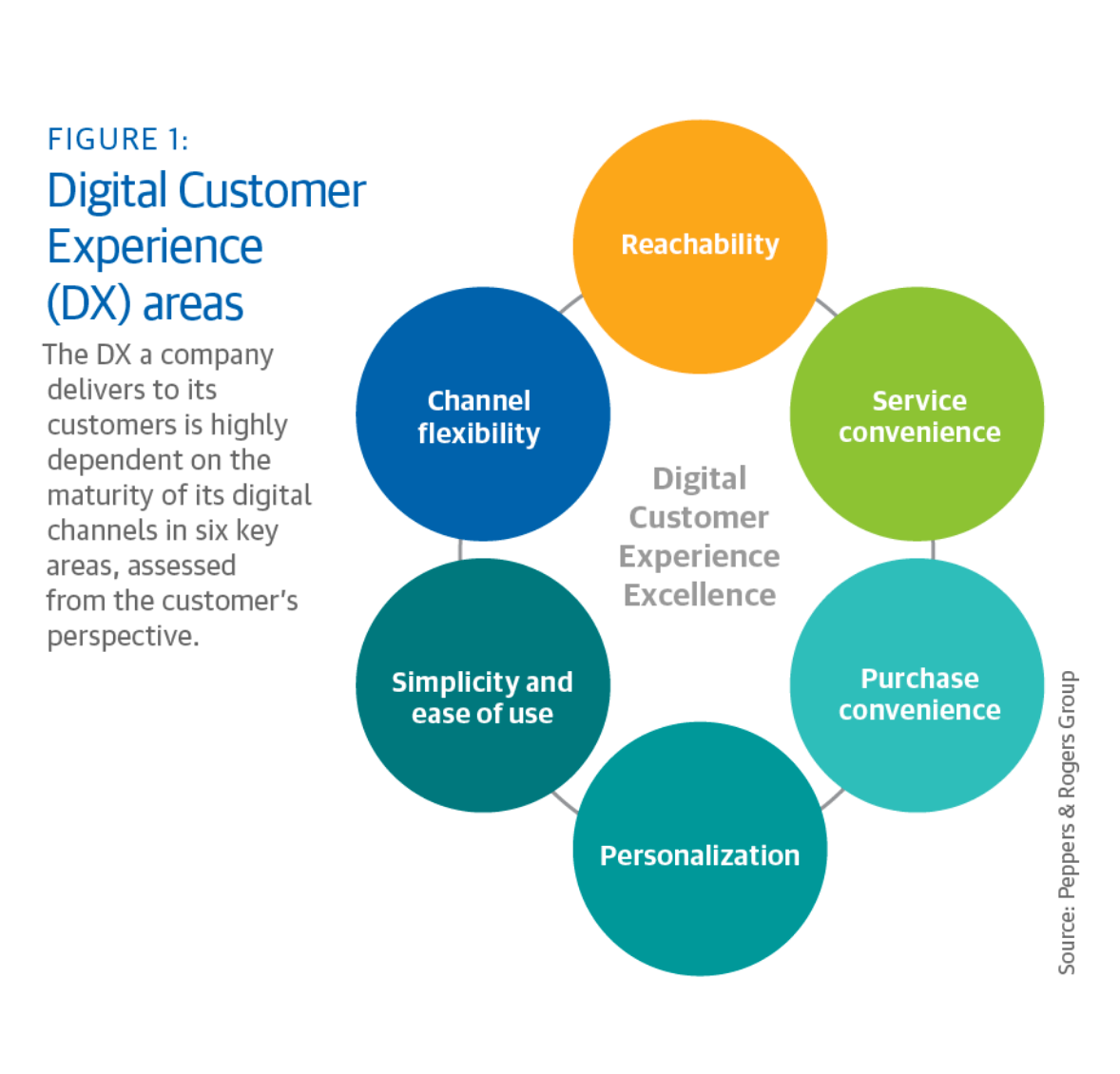 The six key areas associated with a customer’s digital experience
The six key areas associated with a customer’s digital experienceSource[/caption]
So, as you can see, the digital customer experience impacts many areas of your business. It could relate to the experience people have when they email customer support and how convenient it is for them to contact support. It can also relate to the simplicity of your website and whether it works well on multiple devices.
Due to this, you need to take a close look at all the ways somebody interacts with your brand. You then need to consider how you can build upon this experience so that it leaves the customer with a positive impression. The only way you can truly provide customers with a great digital experience is if you take a proactive approach.
The graphic below does a great job of highlighting the difference between a strong proactive approach to managing the customer experience a lackluster approach.
[caption id="" align="aligncenter" width="590"]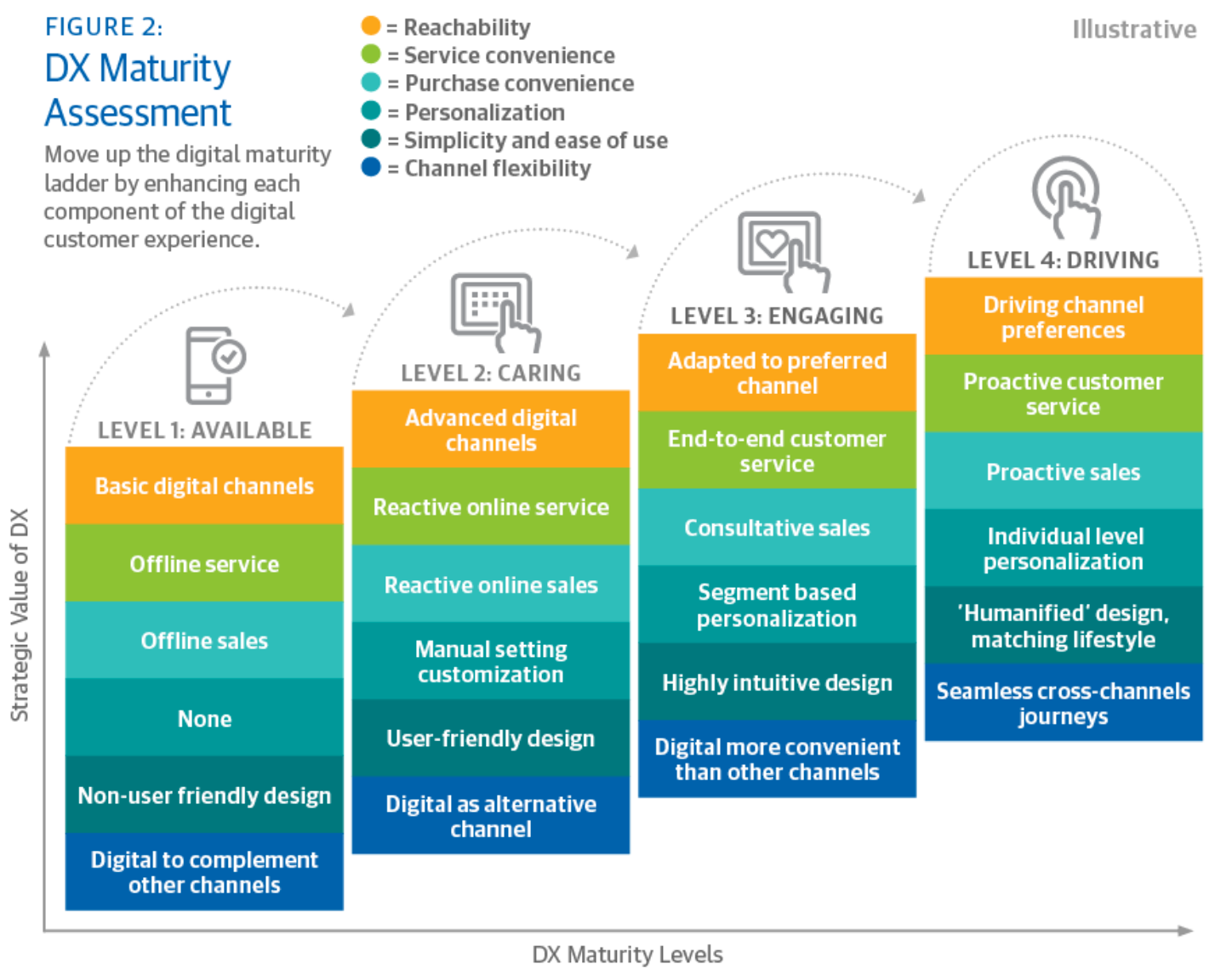 How you can assess the quality of a customer’s digital experience
How you can assess the quality of a customer’s digital experienceSource[/caption]
So, a proactive approach would mean that you monitor and then respond to real-time social media mentions that are associated with your company. It would also mean that you review customer service emails so that you can determine where things are going wrong.
If you can smooth out these issues, you will be able to reduce the negative emotion associated with your brand. This will then result in better ‘digital experiences’ for those that are interacting with your brand. This is especially important when you consider that 17% of people will stop interacting with a brand after one negative interaction.
[caption id="" align="aligncenter" width="590"]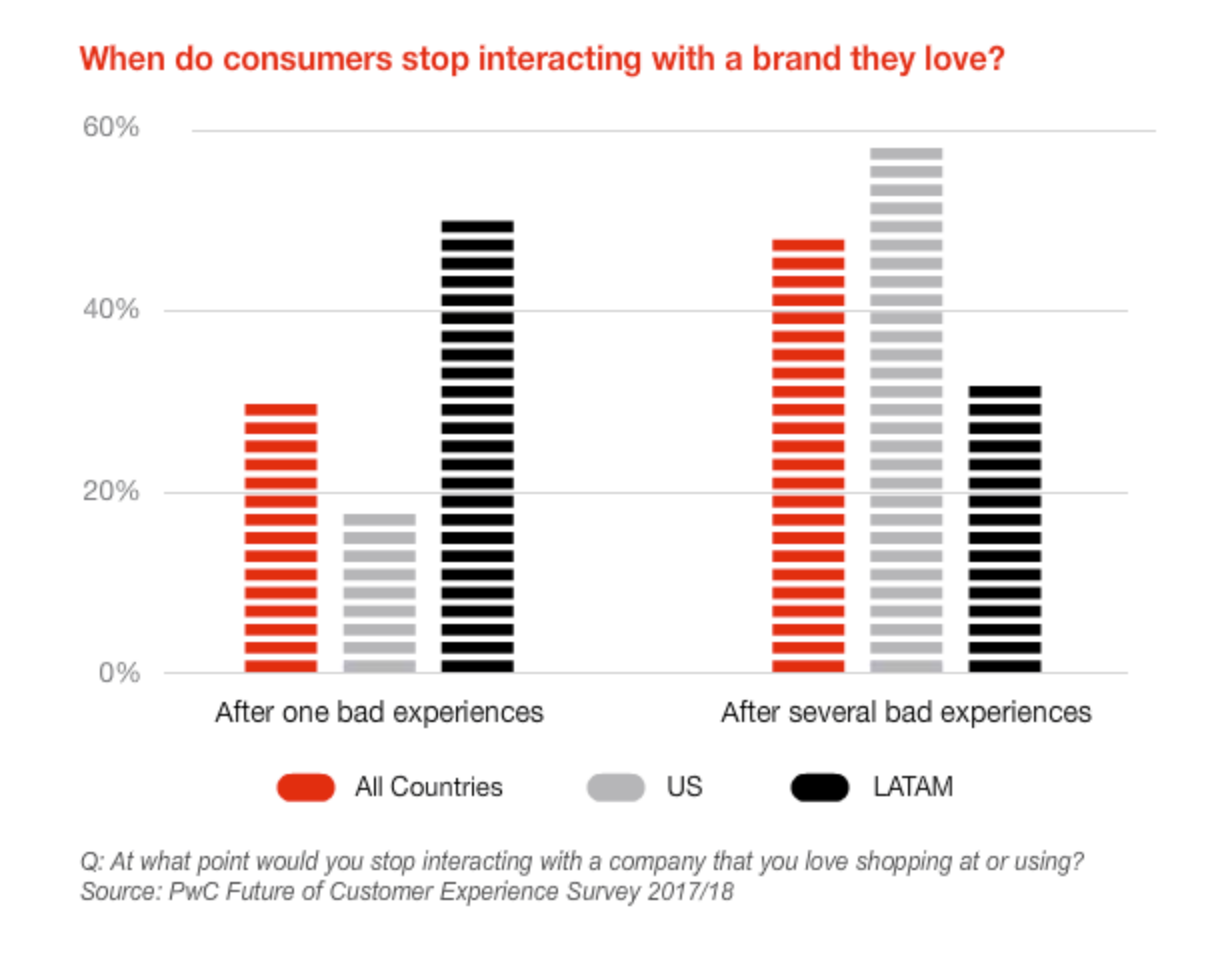 It doesn’t take many bad experiences for a customer to leave
It doesn’t take many bad experiences for a customer to leaveSource[/caption]
Note that if you take steps to improve the digital experience of your customers, you might want to document your efforts and the outcomes of any changes you have implemented. A standard example of this might include a case study or whitepaper that is readily available on your blog. You might also want to consider creating a video, which details the story associated with the positive customer experience.
You can then use it as part of your marketing campaigns, as you can show people that you care about the experience of your target market.
5. Promoting the Values Behind a Brand
Promoting the values behind a brand is another digital marketing trend that’s gathering a lot of steam. This is a digital marketing trend because companies will use digital marketing channels to promote brand values. Additionally, if you go down this route, it’ll likely have an impact on the kind of digital content you produce, both on your website and on other marketing channels.
Now more than ever, people are starting to care about the values behind a brand. More specifically, 71% of people want to buy from brands that have similar values to them.
The graphic below highlights some of the values that people tend to care about whenever they’re thinking about buying from or recommending a particular brand.
[caption id="" align="aligncenter" width="590"]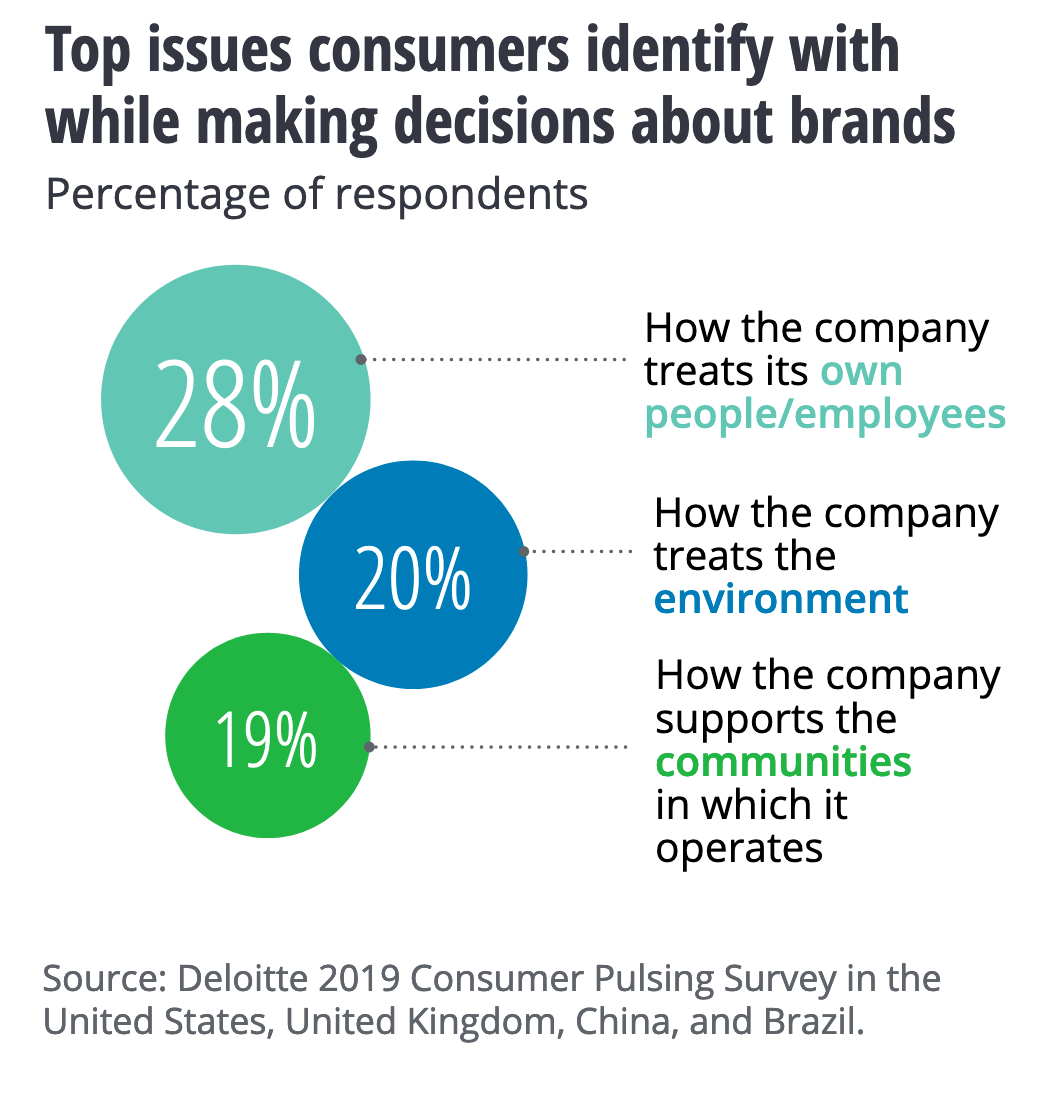 The issues that customers care about when buying from a company
The issues that customers care about when buying from a companySource[/caption]
You need to take this into consideration, and you may want to think about where your brand stands on these three different kinds of values. You might then want to make a commitment to achieving certain kinds of goals that relate to these values. Once you’ve done this, you then need to be transparent so that people can see how you’re trying to embody certain values.
One way you can do this is by announcing how your products align with certain values whenever you release something new. For example, Apple has committed to lessening the environmental impact of their products.
[caption id="" align="aligncenter" width="590"] Apple’s commitment to being carbon neutral
Apple’s commitment to being carbon neutralSource[/caption]
Following this, whenever they launch a new product, Apple will include a section in the promotional reveal that dictates how their new products don’t have a massive negative impact on the environment. If you go to the sales pages of these products, you’ll see that this message is reinforced further.
[caption id="" align="aligncenter" width="590"]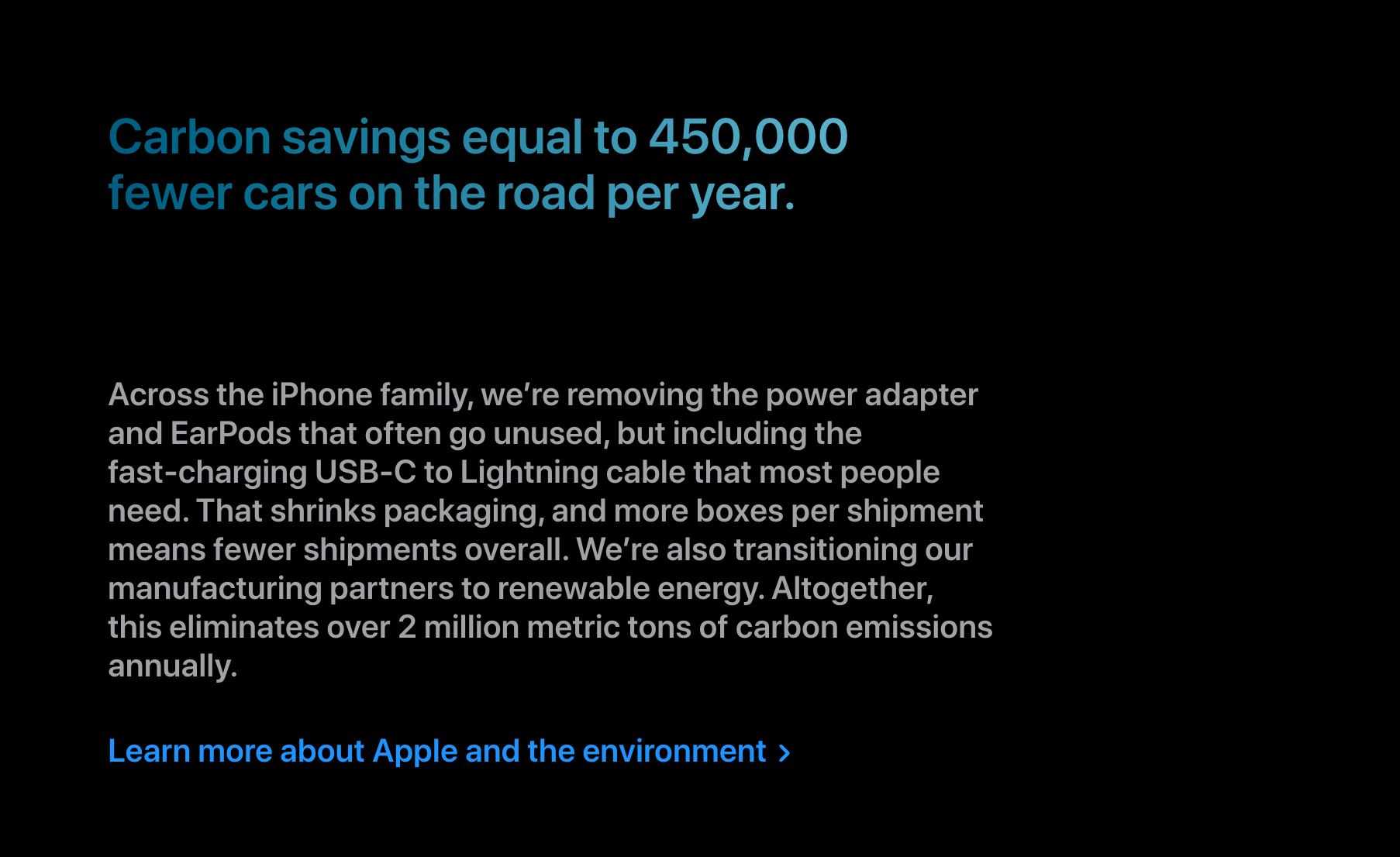 A message from the iPhone 12 Pro sales page that highlights the product’s impact on the environment
A message from the iPhone 12 Pro sales page that highlights the product’s impact on the environmentSource[/caption]
They even publish a report that details how they’re doing in regards to sticking to these values.
[caption id="" align="aligncenter" width="590"]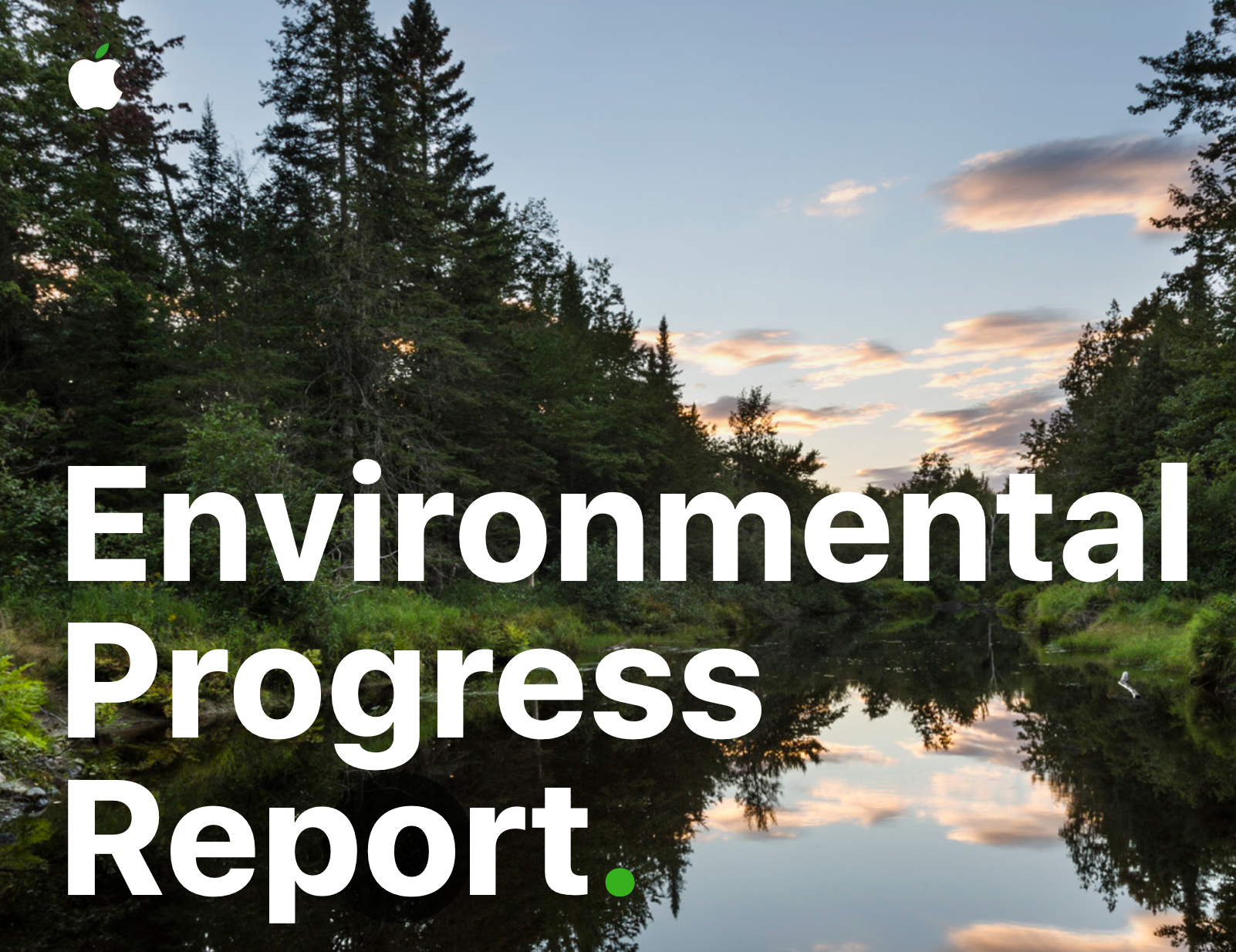 A report released by apple which shows the efforts they’re making to reduce their negative impact on the environment
A report released by apple which shows the efforts they’re making to reduce their negative impact on the environmentSource[/caption]
Following this, you should consider having a page on your website that specifically highlights your company’s values. Alternatively, you might want to have pages dedicated to big issues, such as the environment, employee culture, and the general societal impact of your company.
You might even want to create content that showcases how your company is trying to achieve goals that relate to your values.
There are many ways you can do this, but in most cases, video marketing can be a good way to go. Microsoft’s video on how they will become carbon negative is a good example of a video that is related to this section.
[caption id="" align="aligncenter" width="590"] A video from Microsoft which highlights how they will become carbon negative by 2030
A video from Microsoft which highlights how they will become carbon negative by 2030Source[/caption]
Of course, if you publicly declare that your company is going to adhere to certain goals or values, you need to make sure you follow through. If you fail to do this, you will often create a negative impression, and you may hurt the goodwill you’ve built up over time with your target market.
Due to this, you should also conduct yearly or six-monthly reviews so that you can check if your company is actually sticking to certain values. You can also use this period to determine whether you need to update your values or the way you’re trying to hit certain goals.
If you achieve any big wins when it comes to the goals associated with company values, you should consider how you can promote these wins in the form of content. That might include creating a video or a blog post that you promote using paid marketing.
You might even want to mention these wins as part of your email marketing campaigns. If you work in a B2B company, it might even be a good idea to post this content on your company’s LinkedIn page.
6. Focus on Emerging Markets
Focusing on emerging markets is another digital marketing trend that is getting a lot of attention. That’s because internet adoption and disposable income are rising within these regions, and this now makes them viable regions for most businesses. For instance, if you look at the chart below, you can see how disposable income is rising and will continue to rise in certain emerging markets.
[caption id="" align="aligncenter" width="590"]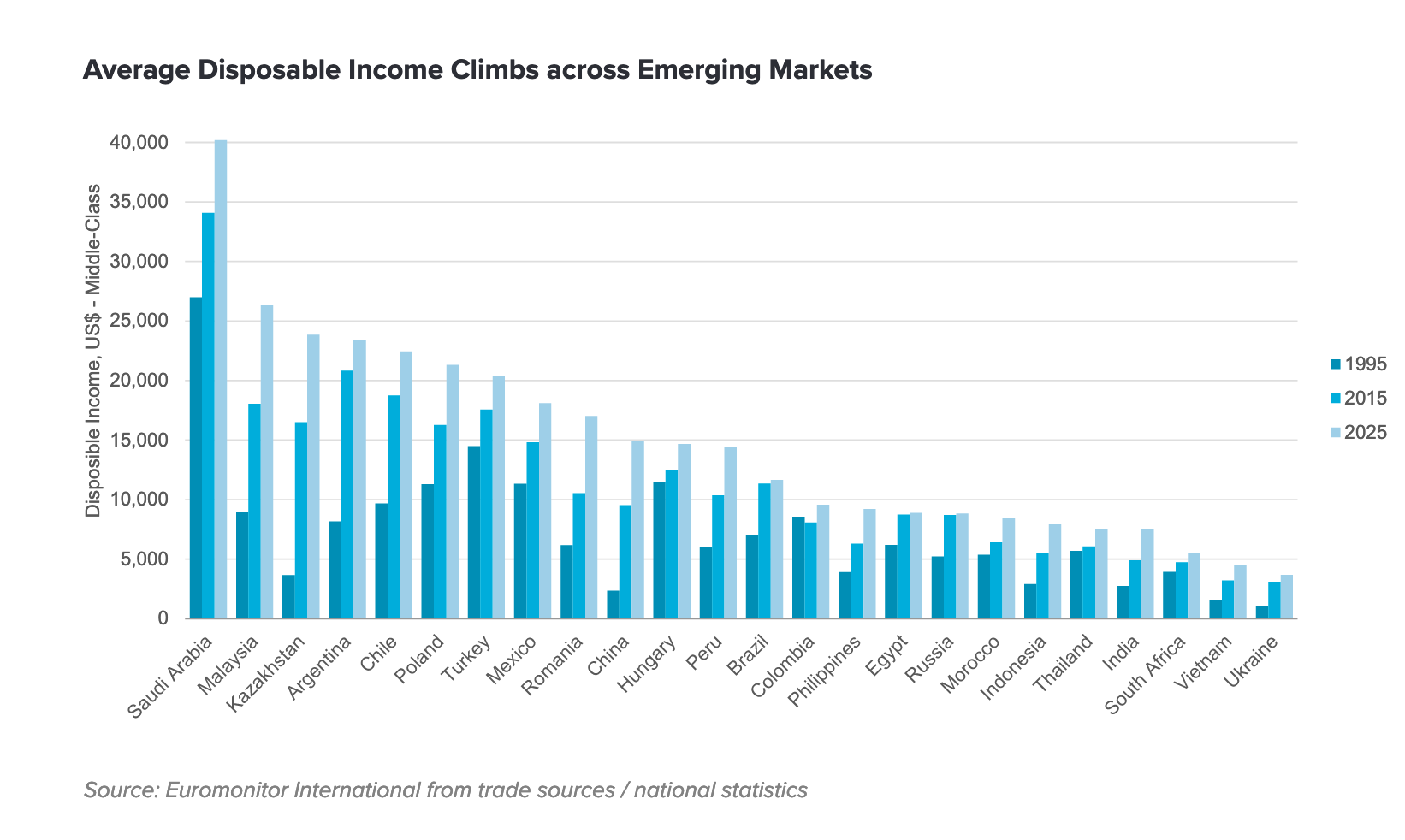 A chart that shows the increase in disposable income across emerging markets
A chart that shows the increase in disposable income across emerging marketsSource[/caption]
This chart also shows that in some regions, internet adoption in emerging markets is growing by at least 20% year-on-year.
[caption id="" align="aligncenter" width="590"]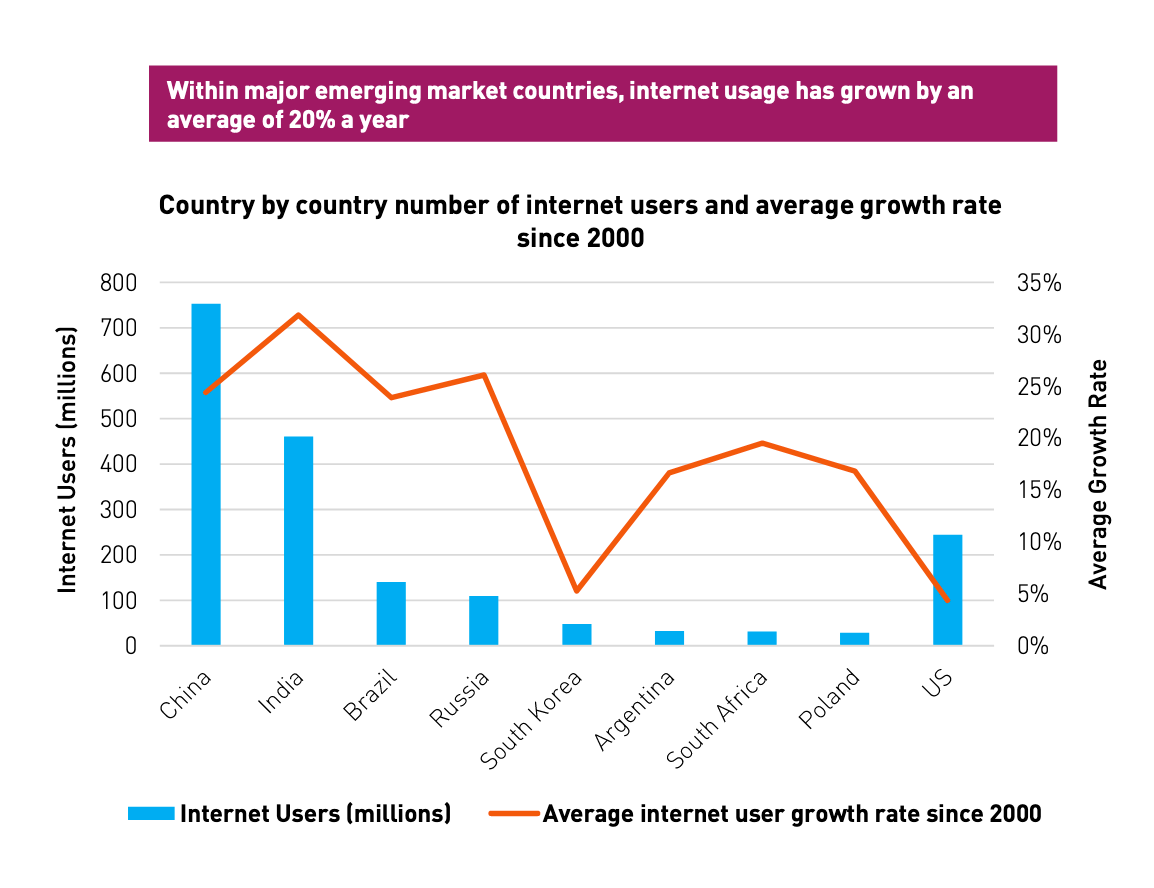 A chart that shows the increase in internet adoption amongst emerging market countries
A chart that shows the increase in internet adoption amongst emerging market countriesSource[/caption]
One of the great things about emerging markets is that they tend to have a lot less competition, and this often results in better ‘digital marketing outcomes.’ For example, you might find that PPC costs are lower simply because there are fewer advertisers in the country you’re looking to expand in. This is highlighted by the chart below, which does a good job of showcasing how CPC costs tend to vary between different regions of the world.
[caption id="" align="aligncenter" width="590"]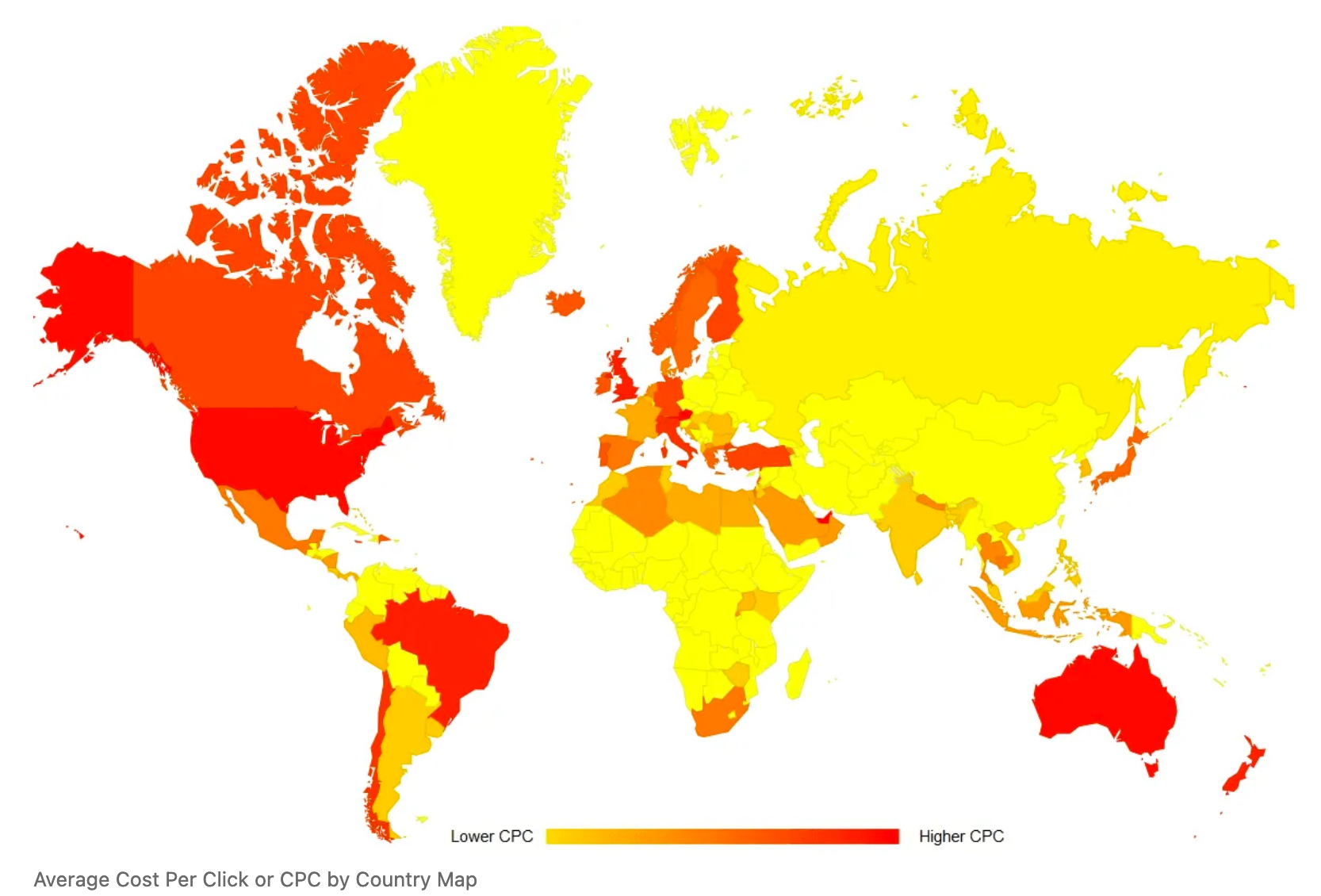 This graphic highlights how the average CPC varies across the world
This graphic highlights how the average CPC varies across the worldSource[/caption]
Following this, you may find that customer acquisition costs will be a lot lower in an emerging market.
If you want to expand into emerging markets, it’s critical that you work with someone that not only understands the language but also understands the culture. After all, you want to make sure your marketing materials are coherent, but you also want to be sure they’re not offensive. If you work with someone that understands the local culture, you will be able to avoid any potentially embarrassing and damaging campaigns.
It’s also worth noting that different kinds of marketing messages will work for different markets. For instance, if you look at the chart below, you’ll notice how different emerging markets are motivated by different things in regards to shopping online.
[caption id="" align="aligncenter" width="590"]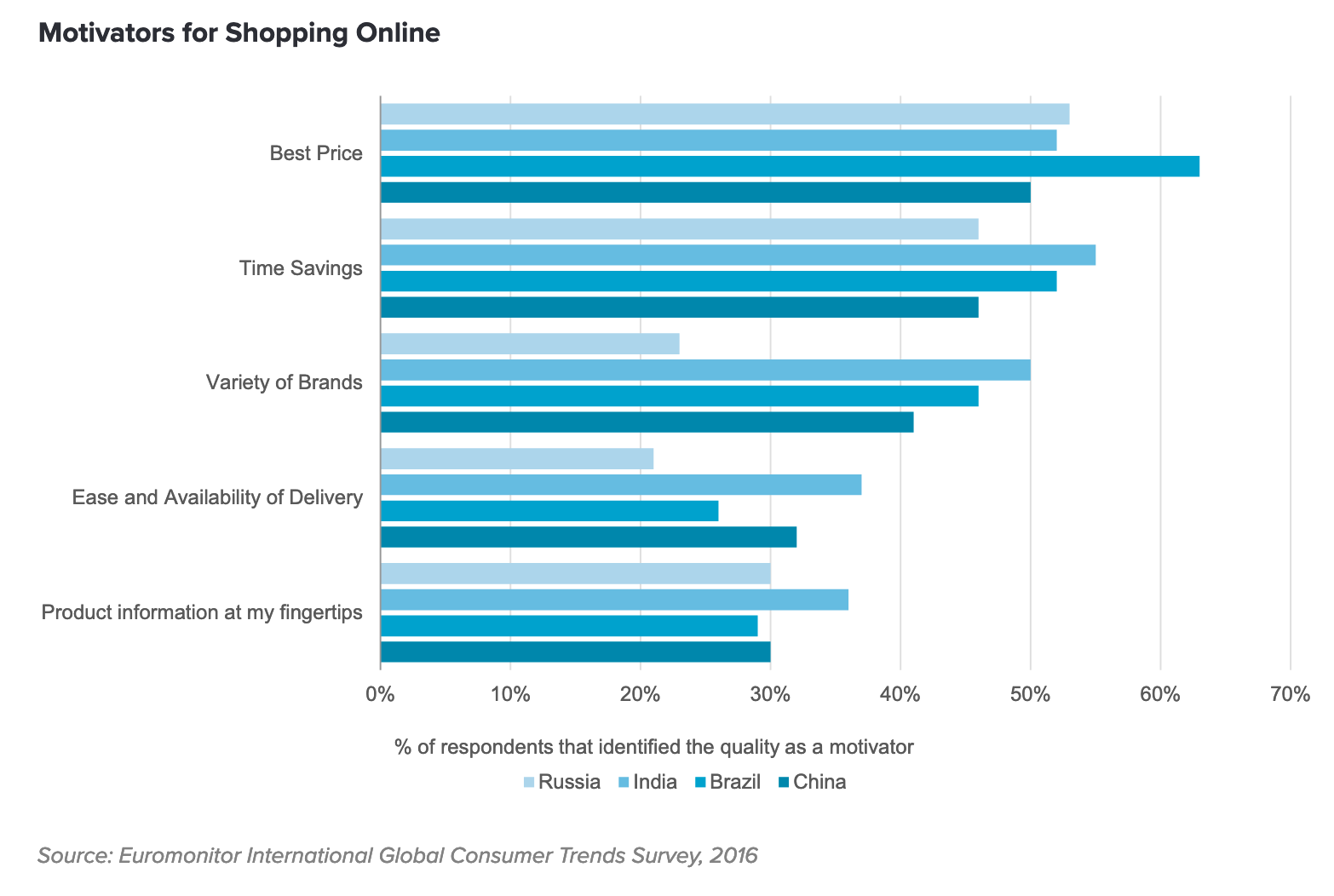 The varying motivations that cause people in emerging markets to shop online
The varying motivations that cause people in emerging markets to shop onlineSource[/caption]
Now, this kind of stat tends to apply more to eCommerce businesses than to something like a B2B business. Yet, it still does a good job of highlighting the different preferences that exist between varying emerging markets.
If you’re looking to expand into an emerging market, there’s a good chance you won’t get things right on your first go, as you literally are going into ‘unknown territory.’ You should accept that it’s going to be a bit of an iterative process and that it's going to take some time for you to develop a solid digital marketing strategy.
It’s because of this difficulty, that you should try to focus on one emerging market at a time. In doing so, you can ensure that you do a brilliant job, and you can then use these lessons when you’re thinking about moving into another market.
In any case, how can you go about establishing a presence in emerging markets? To begin with, you need to select an emerging market that is right for your business. There are many markets you can focus on, but for the most part, you might want to start with the countries mentioned in the graphic below.
[caption id="" align="aligncenter" width="590"]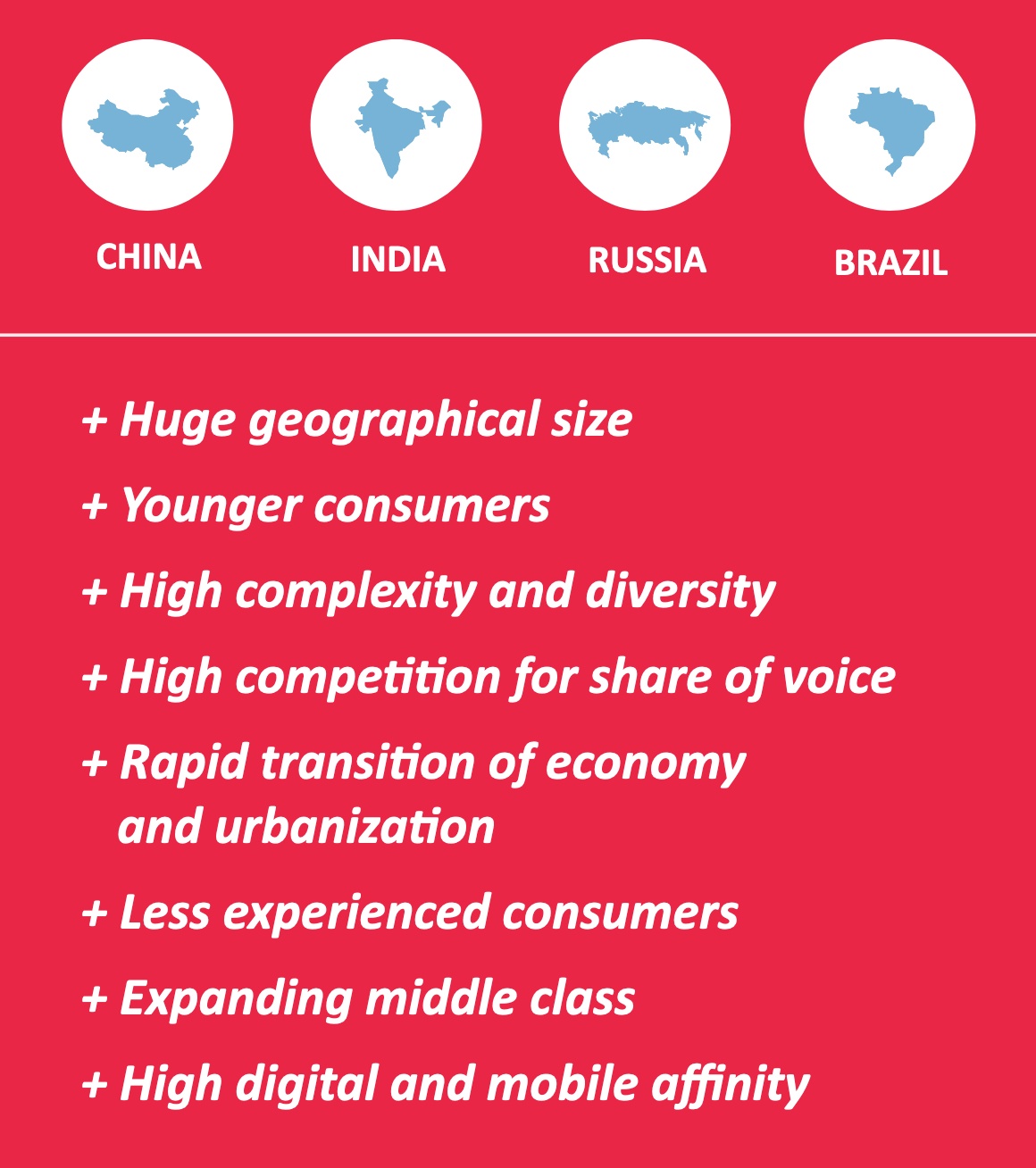 Some of the ‘top’ emerging markets
Some of the ‘top’ emerging marketsSource[/caption]
These regions have a growing middle class, and B2B spending is also growing. For example, China represents the world’s 3rd largest B2B market.
For the sake of this post, let’s suppose that you want to focus on the Brazillian market. If you want to enter this market, you’ll need to think about creating a Portuguese version of your website. Ideally, you want to make it so that people in Brazil automatically get the Portuguese version of the site when they visit.
If you’re going to do this, it’s a good idea to also translate blog content, alongside the general text and landing pages that can be found on your site. By doing this, you will experience a lot of SEO benefits, as your content can now be found by people using Portuguese search terms. If you have any whitepapers or case studies on your website, you should think about translating them too.
As alluded to earlier, if you’re going to translate the content on your website, make sure you work with someone that truly understands the language. Going down this route can be expensive, but it’s the only way you can ensure you end up with quality content that is translated in a clear and coherent manner. If you just use an ‘auto-translate’ tool, you’re not going to have proper translations, and thus your website can discourage the people you’re trying to reach.
You might even want to hire a digital marketer that’s based in the region you want to tackle. They will have a better understanding of the consumers in your region, and this may help you reduce the amount of time it takes to get results.
If you want to quickly test out your marketing materials, you might want to consider running some Google Ads in your chosen emerging market. This isn’t that hard to do since Google Ads caters to most emerging markets.
If you’re looking to promote an eCommerce store, you might also want to run some influencer marketing campaigns. The global influencer market is expected to grow 25% annually from 2019 to 2025, so there is definitely an opportunity when it comes to international influencers. Plus, because these markets are emerging, you’ll find that influencers tend to face fewer inbound inquiries than influencers in North American markets.
This can then mean lower costs for you, thereby allowing you to potentially generate a better return on your influencer marketing campaigns.
7. Podcasting
Podcasting is one of the most obvious digital marketing trends that is starting to gain a lot of attention. Podcast listeners have grown 37.5% in the past three years, and expected to increase. Furthermore, according to an article from Forbes, the number of monthly podcast listeners has grown from 24% to 37% in the past three years.
[caption id="" align="aligncenter" width="590"]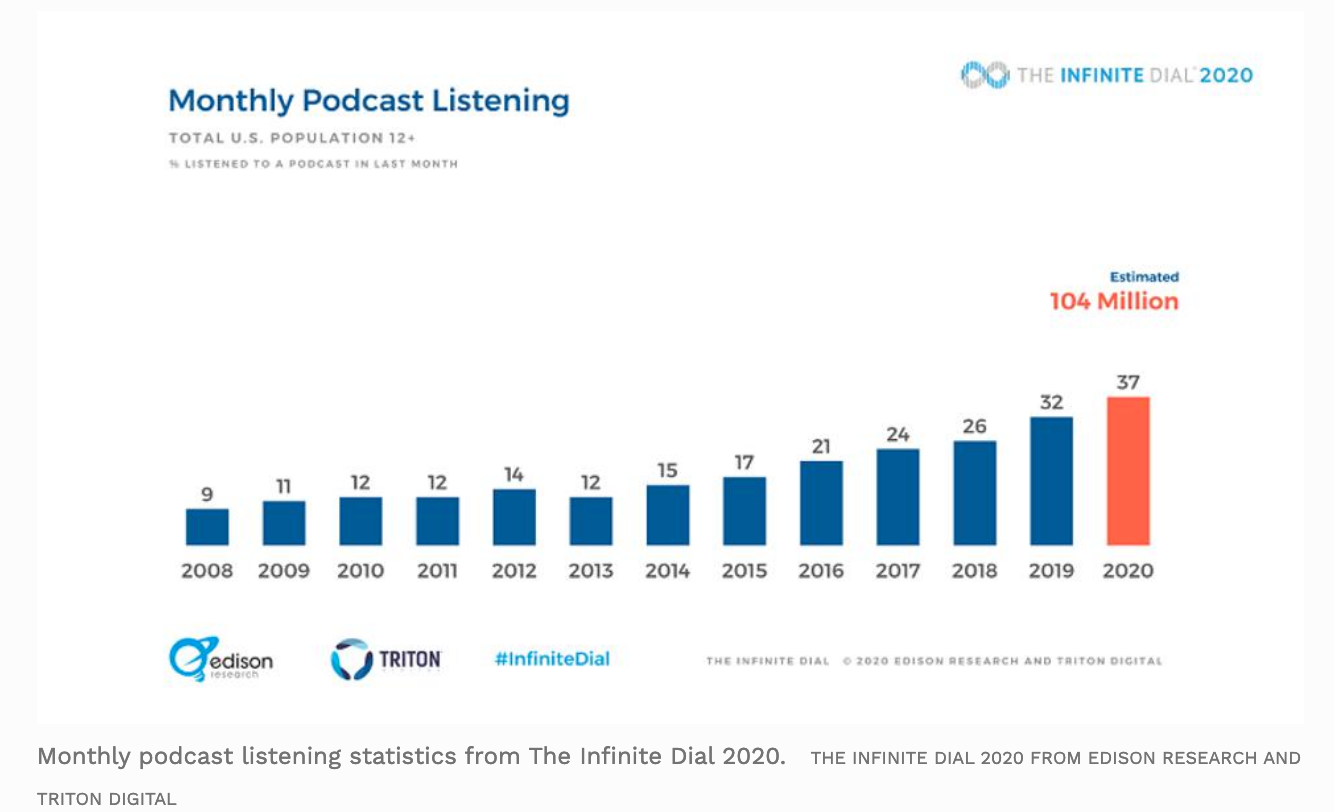 The growth in monthly podcast listeners
The growth in monthly podcast listenersSource[/caption]
This shows that a significant percentage of people keep on listening to podcasts after they start listening to them, thereby indicating that this trend will continue.
One of the good things about podcasts is that they can have a knock-on effect on how much people consume your ‘other’ content marketing efforts. For instance, if you look at the chart below, you’ll notice that blog views increase with the publication of each podcast. However, once podcast publication comes to a halt, there’s a decline in blog post views.
[caption id="" align="aligncenter" width="590"]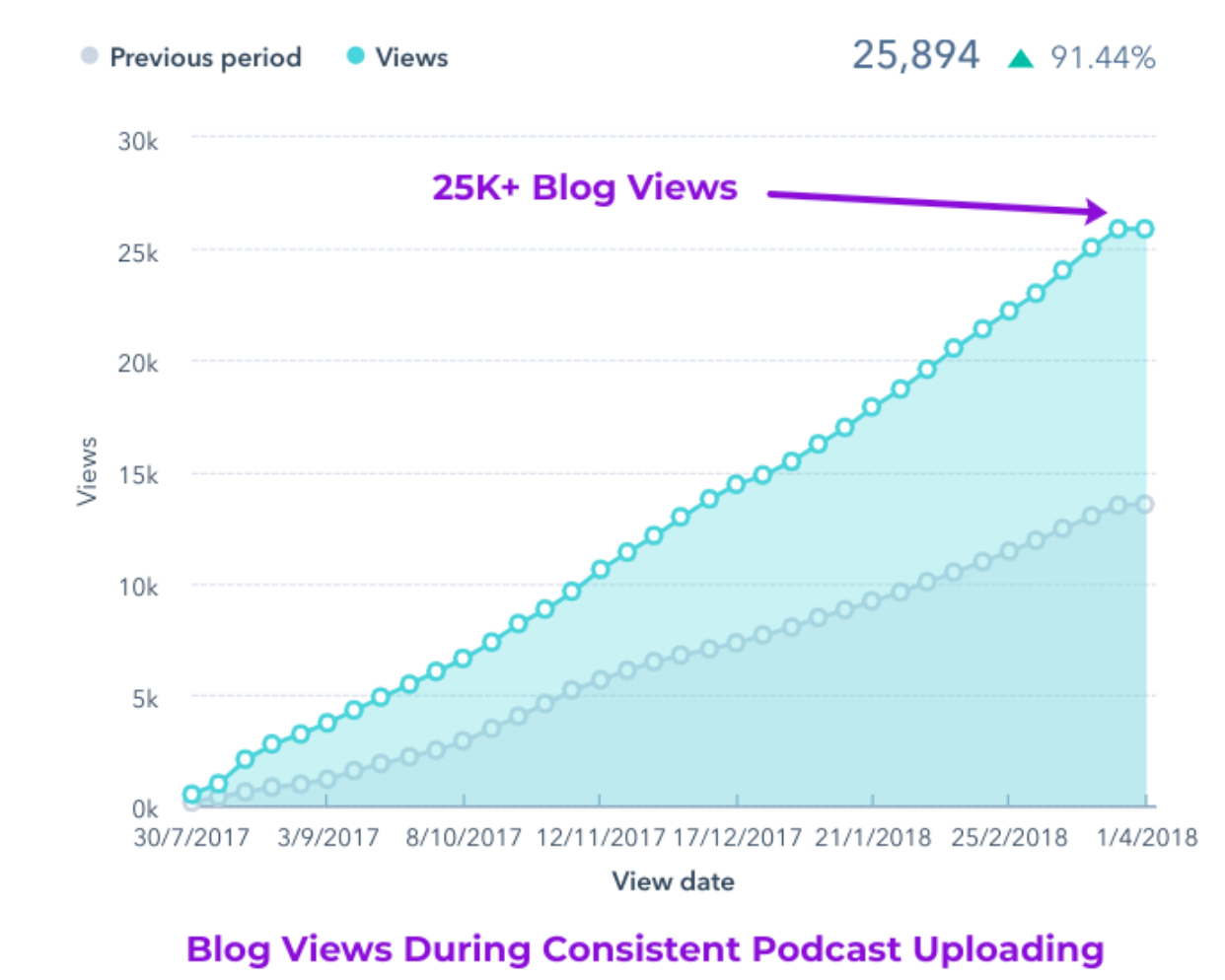 Podcast publication can impact your other content marketing efforts
Podcast publication can impact your other content marketing effortsSource[/caption]
Thus if you want to amplify your other content marketing efforts, podcasting can be a good way to get some traction.
There are generally three ways you can get involved with podcasts:
- Be a guest on podcasts
- Sponsor podcasts
- Launch your own podcast
If you want to be a guest on someone else's podcast, you’ll first need to identify a range of podcasts that might have an interest in hosting you. Perhaps the easiest way to go about this is by searching for podcasts that are associated with your industry.
Ideally, there needs to be some kind of beneficial value proposition here, otherwise, the host might not be interested in having you on. Thus, when you’re pitching a podcast host, you need to discuss how you will help their audience.
For instance, if you run a mortgage brokerage company, you might approach a finance podcast. When pitching to this podcast, you might tell the host that you can help their listeners save money on their mortgage costs and provide case studies that highlight your expertise and ability to deliver results. By doing this, the podcast host will now have an incentive to bring you on, as they now understand how you will benefit their audience.
As mentioned, you can also get involved with podcasts by sponsoring them. This method is worthwhile since 63% of people have said that they’d try out a new product or service after listening to a podcast ad.
[caption id="" align="aligncenter" width="590"]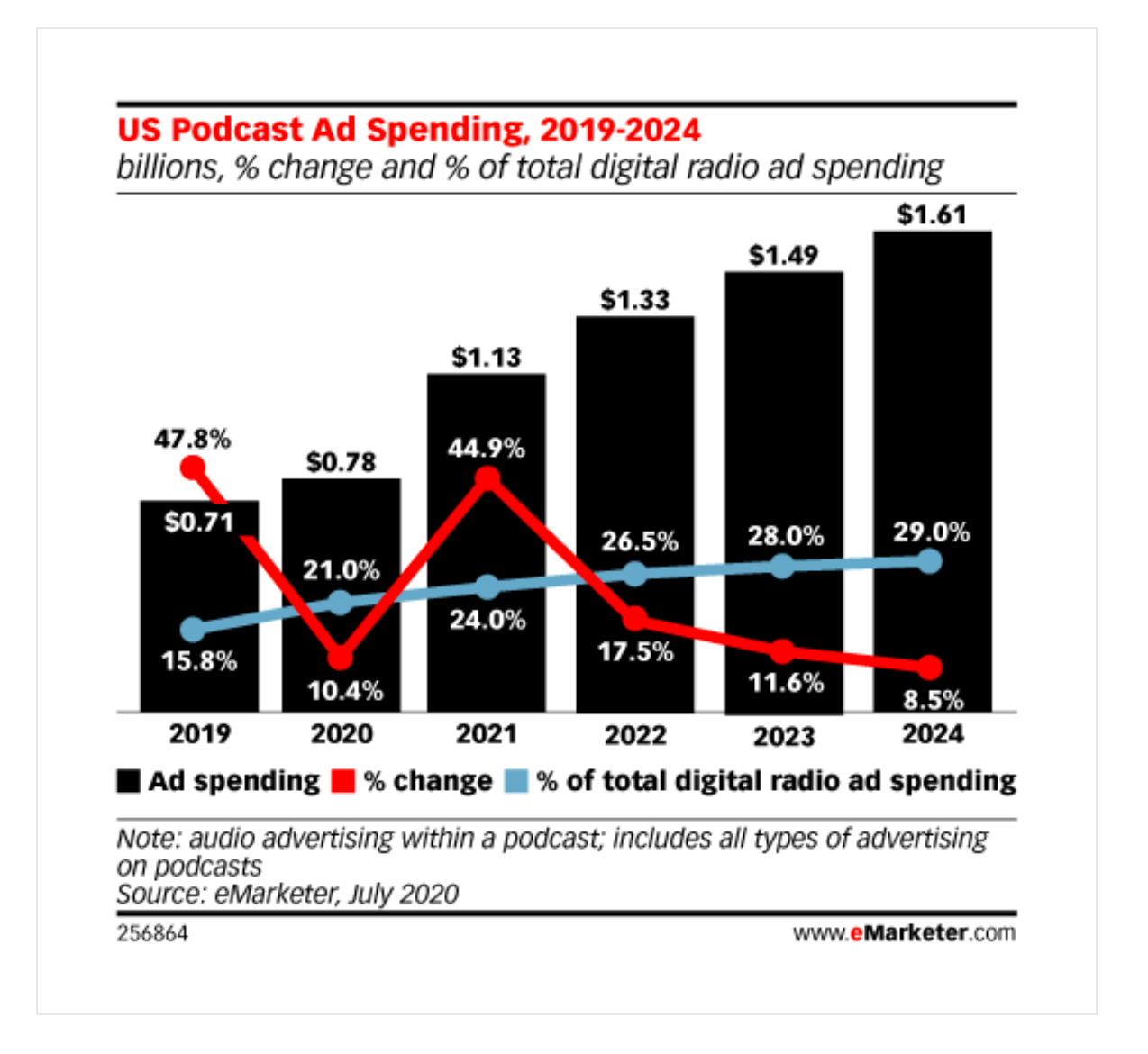 US Podcast spending is on the rise
US Podcast spending is on the riseSource[/caption]
Podcast ad spending is also increasing, and this is a good sign that investing in podcasts ads is a worthwhile endeavor. If you want to sponsor a podcast, you typically have to follow the same process you’d follow if you wanted to be a guest on a podcast.
You’d have to find podcasts with a relevant audience, and you’d then need to get in touch and let them know you’d like to be a sponsor. Note that some podcasts will have a dedicated email for sponsors on their website.
Some hosts are very particular about the things they sponsor, and so you’ll probably have to explain the benefits of your solution and why it’s a good fit for their audience.
The amount you pay to sponsor a podcast depends on the stats associated with a podcast. Thus, you’ll only know how much sponsorships cost once you actually get in touch with a particular show. That said, here is some data which highlights some of the average costs people face when sponsoring a podcast.
[caption id="" align="aligncenter" width="590"] The average CPM’s you might face when investing in podcast ads
The average CPM’s you might face when investing in podcast adsSource[/caption]
As you can see, you’re generally charged in a CPM format, which means you’re charged per every 1000 listeners of a podcast.
As mentioned, the last option you have is to host a podcast of your own. Launching your own podcast sounds like a daunting task, but if you’re already creating some kind of content, it’s not going to be too challenging.
In terms of the actual logistics involved, you just need to upload your audio files to a platform like Lybisn or Anchor. After doing this, these platforms will then provide you with an ‘RSS feed’ that you can submit to popular podcasting platforms like Apple Podcasts or Spotify.
When it comes to the content associated with your podcast, you should try to focus on creating podcast content that helps your audience solve a problem. You might also want to host some interviews with people that have relevant industry expertise.
If you want to promote your podcast, being a guest on another relevant podcast can get you off to a good start.
You might also want to invest in ads, and you’ll also find that certain podcast apps allow you to run targeted ads that will help you reach your target audience.
Of course, there’s nothing stopping you from using traditional ad platforms to promote your podcast. For example, you could run some Facebook Ads that promote a web page dedicated to your podcast.
Note that as your podcast audience grows, you should ask people to leave a positive review for the show. This will then help the general discoverability of the podcast, and it will also signal to potential listeners that your podcast is worth their time.
8. Voice Search
As ‘smart speaker’ devices such as Amazon Alexa and Google Home become increasingly popular, more and more people are performing ‘voice searches.’ In fact, if you look at the chart below, you can see that there’s been a steady increase in the number of people that use ‘voice assistants.’
[caption id="" align="aligncenter" width="590"]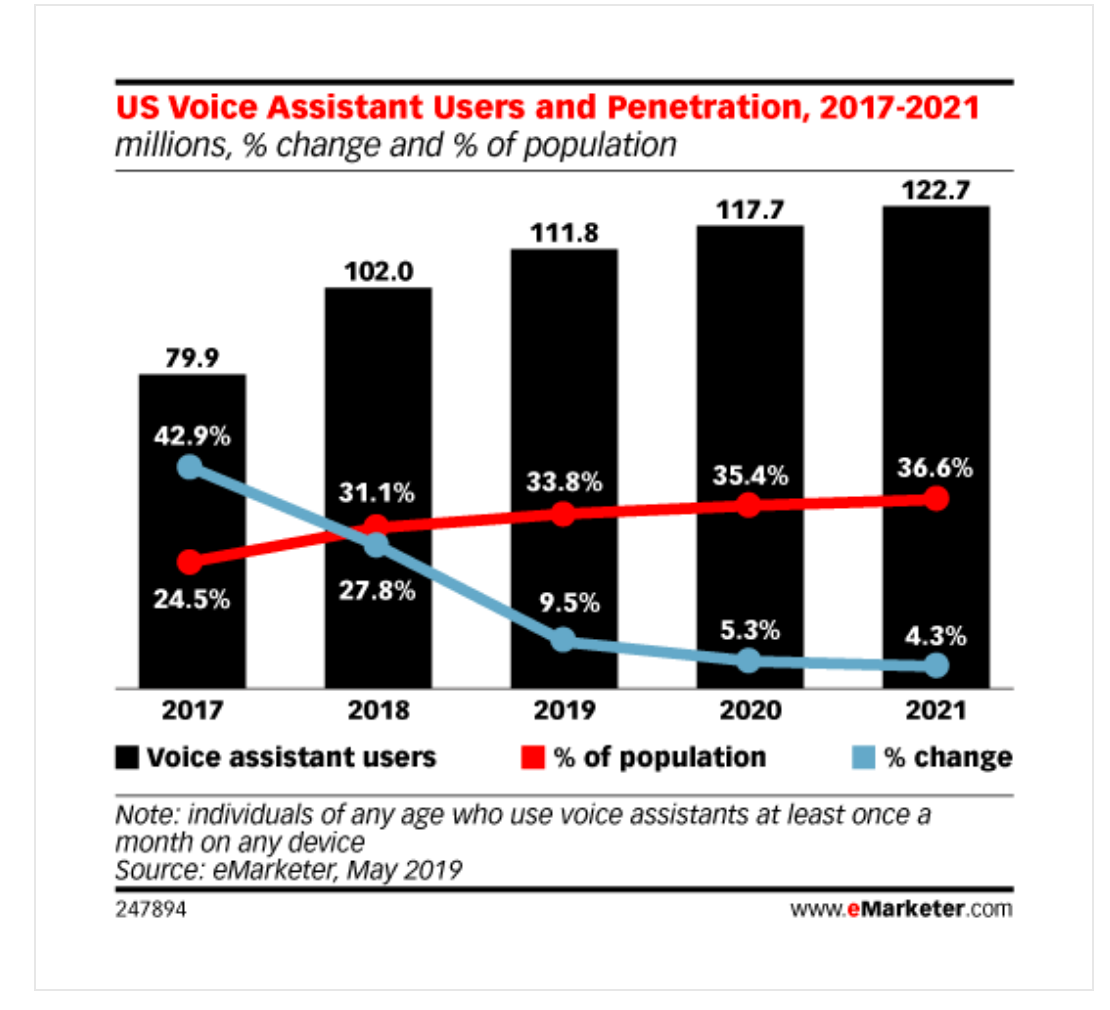 More and more people are using voice search
More and more people are using voice searchSource[/caption]
Smartphone voice assistants, such as Siri, are also becoming better and more commonly used. So much so that 27% of the global online population uses the voice search feature on their phone.
[caption id="" align="aligncenter" width="590"]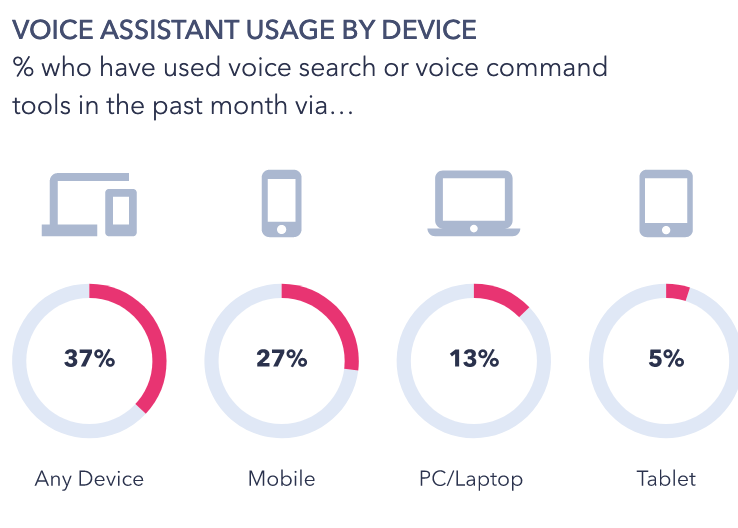 Voice searches are split between different devices
Voice searches are split between different devicesSource[/caption]
Another study also found that 56% of people use a voice search whenever they need to look something up.
[caption id="" align="aligncenter" width="590"]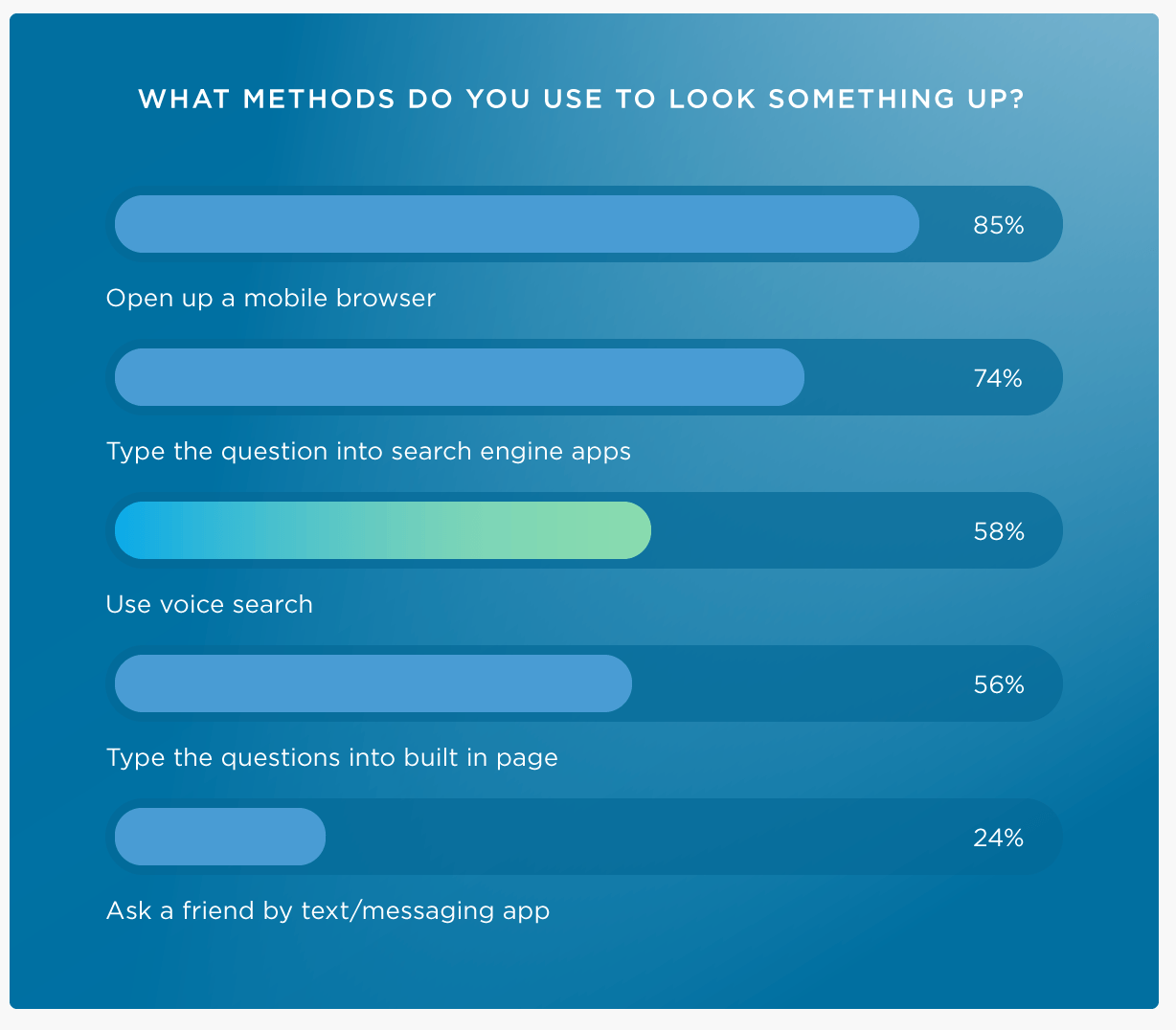 The varying ways people look up information
The varying ways people look up informationSource[/caption]
Voice search works well for a variety of business applications, but it’s notably important for local businesses. There’s data to back this up too, as 58% of people have used voice search in order to learn more about local small businesses.
Now, you might think that voice search isn’t something that you should optimize for because it doesn’t lead to any direct business. However, a significant number of voice searches result in website visits. After all, one study found that 27% of people visit the website of a local website after performing a voice search.
Of course, it’s worth noting that this stat can also apply to ‘non-local’ businesses, and so you shouldn’t shun voice searches if you don’t have a local business.
If you want to benefit from voice search, there are two things that you need to do. If you already have some SEO experience, implementing these tactics shouldn’t be too hard. First, you need to think about creating content that will be relevant to those that are actually performing voice searches. Since most people use voice searches to ask questions, you should consider creating content that aims to answer the kinds of questions your target audience will ask.
If you don’t know where to begin, think about some of the common questions you encounter when speaking to your target audience. If you can answer these questions in the form of a blog post, your website may be used to answer someone’s voice search query.
If you need some inspiration, here are some of the terms that are often included in a voice search.
[caption id="" align="aligncenter" width="590"]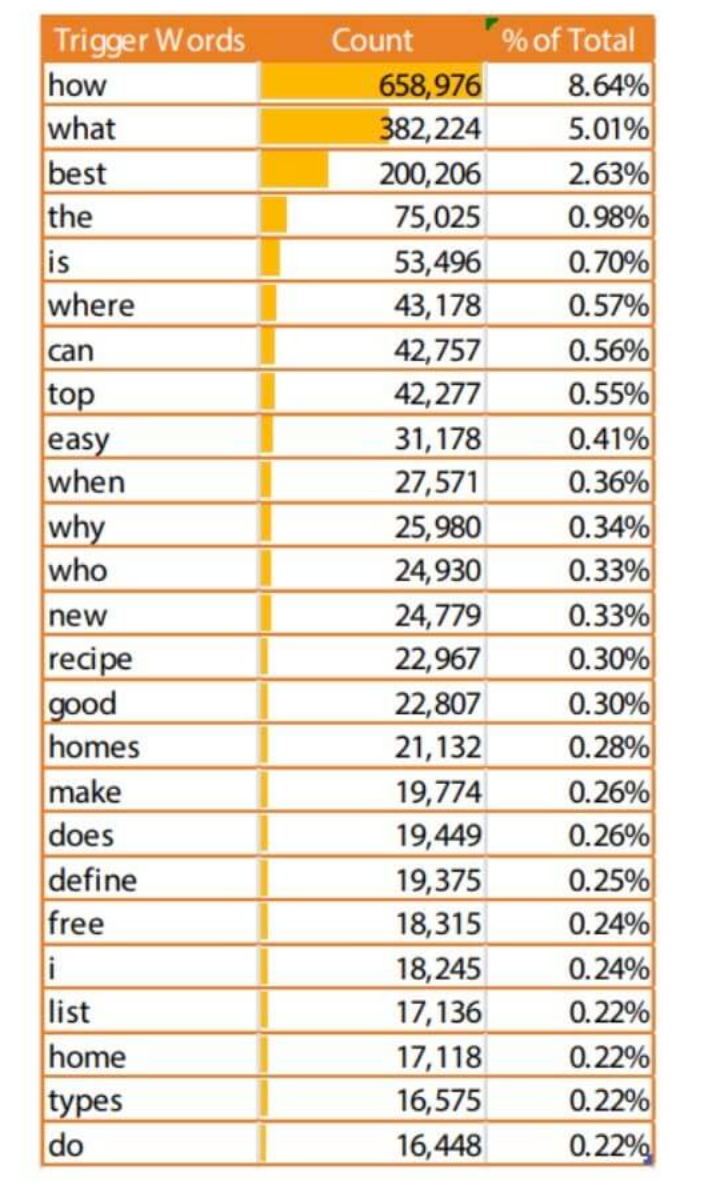 Common words used in voice searches
Common words used in voice searchesSource[/caption]
If you want to make sure this content is used as a response to a voice search, you need to use the right kinds of phrases. This is especially important, as the phrases and keywords strings used for voice searches tend to differ from those used for actual Google searches.
For example, suppose someone is performing a voice search so that they can learn how to keep their website safe from hackers. Someone performing this voice search might say something like, ‘How do I make sure my website doesn’t get hacked.’ If someone was performing a Google search, they might instead use a more contracted, precise search string, such as ‘protect website from hackers.’
Following this, if you want to make sure your website is used for voice searches, you need to think about using the kind of phrases that will be used within voice searches. The easiest way to do this is by simply thinking of the kinds of keywords someone might use whenever they’re performing a voice search that is relevant to your niche. In doing so, you should be able to further improve the ‘discoverability’ of your content when it comes to voice search SEO.
Secondly, you need to use structured data on your site so search engines recognize that your site is optimized for voice search. You can do this by making use of the ‘Speakable’ schema markup offered by Google.
Below you can see an example of this schema and how it can be implemented on a site.
[caption id="" align="aligncenter" width="590"] An example of the ‘Speakable Schema’ markup
An example of the ‘Speakable Schema’ markupSource[/caption]
If you use these markup on your site, you will signal to Google that your site can help out with voice search queries. This will then increase the odds of Google considering your content when it’s deciding on how it should respond to a given voice search query.
If you don’t have anyone on your marketing team that can install this code, you might want to reach out to an SEO agency. It’s important you bring on a professional, as you might incorrectly install this code and then unintentionally harm your website’s ‘voice search SEO.’
Takeaways
In this post, we’ve taken a look at some of the top digital marketing trends that are impacting the marketing world.
Acting on all of these trends is going to be difficult, and so you may just want to pick one or two that are best suited to your business. Once you implement those and you begin to see some results, you can then think about moving onto the other marketing tactics that are mentioned in this post.